LG Electronics USA MU40PA15 40" PDP Monitor User Manual 0355Aen
LG Electronics USA 40" PDP Monitor 0355Aen
User Manual

PLASMA MONITOR
OWNER’S MANUAL
Please read this owner’s manual carefully before operating the
Monitor.
Retain it for future reference.
Record model number and serial number of the Monitor.
See the label attached on the back of the Monitor and quote
this information to your dealer when you require service.
Model number :
Serial number :
MODEL : MU-40PA15
MU-40PA15A
MU-40PA15B
MU-40PA15G
MU-40PA15K
MU-40PA15S
P/NO : 3828VA0355A (NP00KC)
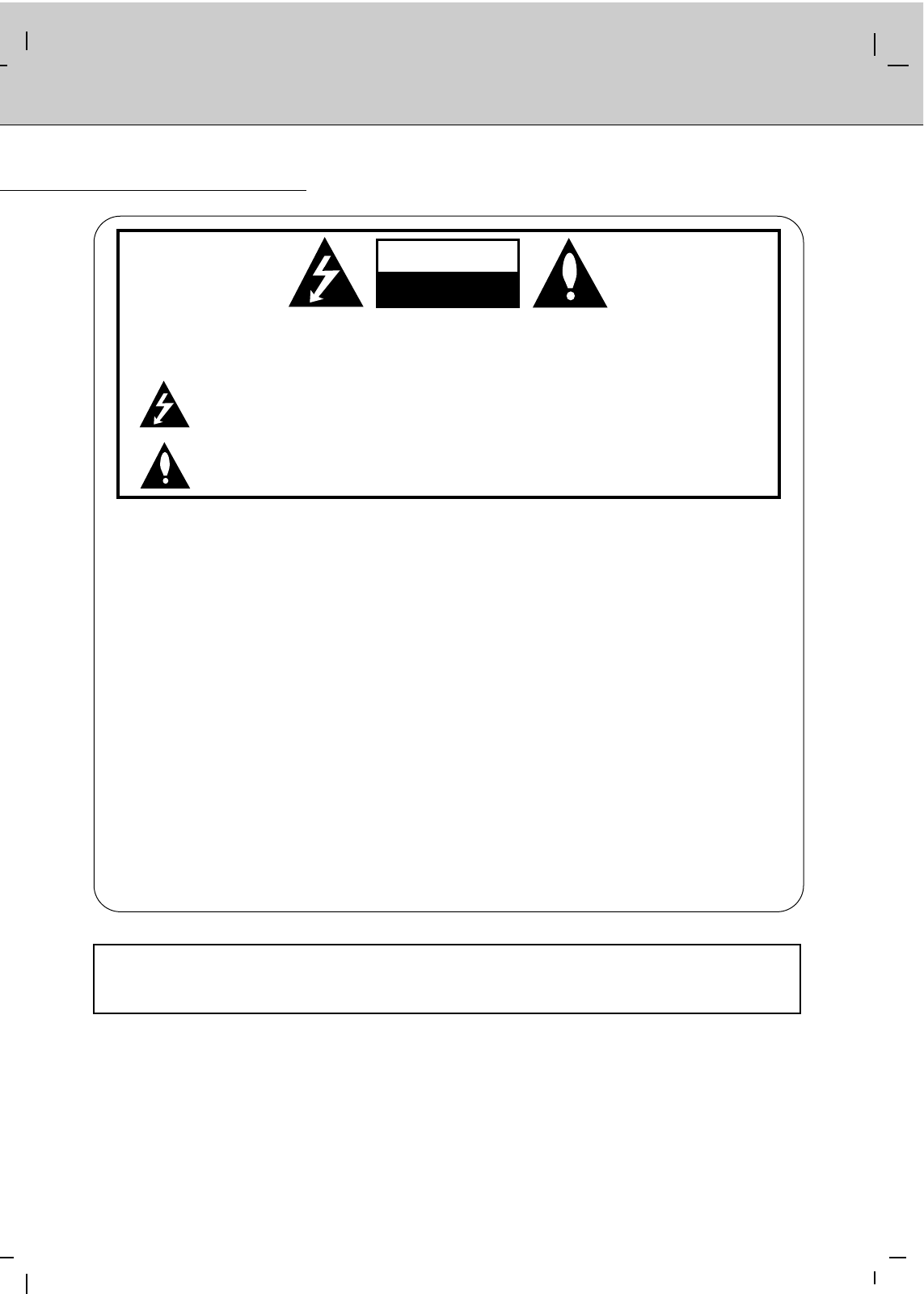
2
WARNING
WARNING:
TO REDUCE THE RISK OF ELECTRIC SHOCK DO NOT REMOVE COVER (OR BACK). NO
USER SERVICEABLE PARTS INSIDE. REFER TO QUALIFIED SERVICE PERSONNEL.
The lightning flash with arrowhead symbol, within an equilateral triangle, is intended to alert the
user to the presence of uninsulated “dangerous voltage” within the product’s enclosure that may
be of sufficient magnitude to constitute a risk of electric shock to persons.
The exclamation point within an equilateral triangle is intended to alert the user to the presence
of important operating and maintenance (servicing) instructions in the literature accompanying
the appliance.
WARNING:
TO PREVENT FIRE OR SHOCK HAZARDS, DO NOT EXPOSE THIS PRODUCT TO RAIN OR MOIS-
TURE.
FCC NOTICE
• A Class B digital device
This equipment has been tested and found to comply with the limits for a Class B digital device, pursuant
to Part 15 of the FCC Rules. These limits are designed to provide reasonable protection against harmful
interference in a residential installation. This equipment generates, uses and can radiate radio frequency
energy and, if not installed and used in accordance with the instructions, may cause harmful interference to
radio communications. However, there is no guarantee that interference will not occur in a particular instal-
lation. If this equipment does cause harmful interference to radio or television reception, which can be deter-
mined by turning the equipment off and on, the user is encouraged to try to correct the interference by one
or more of the following measures:
- Reorient or relocate the receiving antenna.
- Increase the separation between the equipment and receiver.
- Connect the equipment into an outlet on a circuit different from that to which the receiver is connected.
- Consult the dealer or an experienced radio/TV technician for help.
• Any changes or modifications not expressly approved by the party responsible for
compliance could void the user’s authority to operate the equipment.
WARNING
RISK OF ELECTRIC SHOCK
DO NOT OPEN
WARNING
TO REDUCE THE RISK OF FIRE AND ELECTRIC SHOCK, DO NOT EXPOSE THIS PRODUCT TO
RAIN OR MOISTURE.
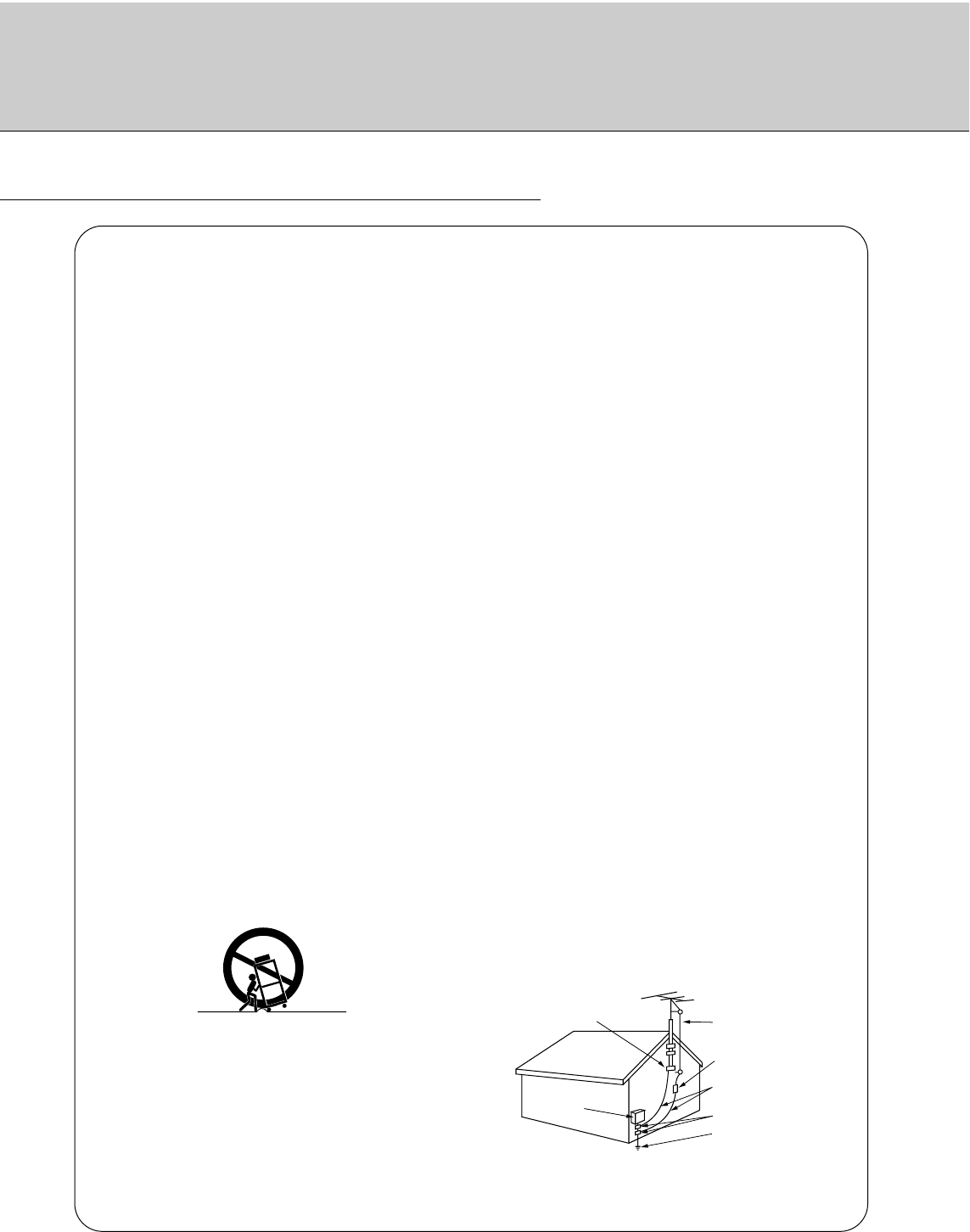
3
Important safeguards for you and your new product
Your product has been manufactured and tested with your safety in mind. However, improper use can result in potential electrical
shock or fire hazards. To avoid defeating the safeguards that have been built into your new product, please read and observe the
following safety points when installing and using your new product, and save them for future reference.
Observing the simple precautions discussed in this booklet can help you get many years of enjoyment and safe operation that are
built into your new product.
This product complies with all applicable U.S. Federal safety requirements, and those of the Canadian Standards Association.
1. Read Instructions
All the safety and operating instructions should be read before
the product is operated.
2. Follow Instructions
All operating and use instructions should be followed.
3. Retain Instructions
The safety and operating instructions should be retained for
future reference.
4. Heed Warnings
All warnings on the product and in the operating instructions
should be adhered to.
5. Cleaning
Unplug this product from the wall outlet before cleaning. Do not
use liquid cleaners or aerosol cleaners. Use a damp cloth for
cleaning.
6. Water and Moisture
Do not use this product near water, for example, near a bath tub,
wash bowl, kitchen sink, or laundry tub, in a wet basement, or
near a swimming pool.
7. Accessories Carts and Stands
Do not place this product on a slippery or tilted surface, or on an
unstable cart, stand, tripod, bracket, or table. The product may
slide or fall, causing serious injury to a child or adult, and serious
damage to the product. Use only with a cart, stand, tripod, brack-
et, or table recommended by the manufacturer, or sold with the
product. Any mounting of the product should follow the manu-
facturer’s instructions, and should use a mounting accessory
recommended by the manufacturer.
8. Transporting Product
A product and cart combination should be moved with care.
Quick stops, excessive force, and uneven surfaces may cause
the product and cart combination to overturn.
9. Attachments
Do not use attachments not recommended by the product man-
ufacturer as they may cause hazards.
10. Ventilation
Slots and openings in the cabinet are provided for ventilation
and to ensure reliable operation of the product and to protect it
from overheating, and these openings must not be blocked or
covered. The openings should never be blocked by placing the
product on a bed, sofa, rug, or other similar surface. This prod-
uct should not be placed in a built-in installation such as a book-
case or rack unless proper ventilation is provided or the manu-
facturer’s instructions have been adhered to.
11. Power Sources
This product should be operated only from the type of power
source indicated on the marking label. If you are not sure of the
type of power supply to your home, consult your product dealer
or local power company. For products intended to operate from
battery power, or other sources, refer to the operating instruc-
tions.
12. Power-Cord Polarization
This product is equipped with a three-wire grounding type plug,
a plug having a third (grounding) pin. This plug will only fit into
the grounding-type power outlet. This is a safety feature. If you
are unable to insert the plug into the outlet, contact your electri-
cian to replace your obsolete outlet. Do not defeat the safety pur-
pose of the grounding-type plug.
13. Power-Cord Protection
Power-supply cords should be routed so that they are not likely
to be walked on or pinched by items placed upon or against
them, paying particular attention to cords at plugs, convenience
receptacles, and the point where they exit from the product.
14. Outdoor Antenna Grounding
If an outside antenna or cable system is connected to the prod-
uct, be sure the antenna or cable system is grounded so as to
provide some protection against voltage surges and built-up sta-
tic charges. Article 810 of the National Electrical Code (U.S.A.),
ANSI/ NFPA 70 provides information with regard to proper
grounding of the mast and supporting structure, grounding of the
lead-in wire to an antenna discharge unit, size of grounding con-
ductors, location of antenna-discharge unit, connection to
grounding electrodes, and requirements for the grounding elec-
trode.
PORTABLE CART WARNING
(Continued on next page)
SAFETY INSTRUCTIONS
Antenna Lead in Wire
Antenna Discharge Unit
(NEC Section 810-20)
Grounding Conductor
(NEC Section 810-21)
Ground Clamps
Power Service Grounding
Electrode System (NEC
Art 250, Part H)
Ground Clamp
Electric Service
Equipment
Example of Grounding According to National
Electrical Code Instructions
NEC - National Electrical Code

4
SAFETY INSTRUCTIONS
15. Lightning
For added protection for this product (receiver) during a lightning
storm, or when it is left unattended and unused for long periods
of time, unplug it from the wall outlet and disconnect the anten-
na or cable system. This will prevent damage to the product due
to lightning and power-line surges.
16. Power Lines
An outside antenna system should not be located in the vicinity
of overhead power lines or other electric light or power circuits,
or where it can fall into such power lines or circuits. When
installing an outside antenna system, extreme care should be
taken to keep from touching such power lines or circuits as con-
tact with them might be fatal.
17. Overloading
Do not overload wall outlets and extension cords as this can
result in a risk of fire or electric shock.
18. Object and Liquid Entry
Never push objects of any kind into this product through open-
ings as they may touch dangerous voltage points or short-out
parts that could result in a fire or electric shock. Never spill liquid
of any kind on the product.
19. Servicing
Do not attempt to service this product yourself as opening or
removing covers may expose you to dangerous voltage or other
hazards. Refer all servicing to qualified service personnel.
20. Damage Requiring Service
Unplug this product from the wall outlet and refer servicing to
qualified service personnel under the following conditions:
a. If the power-supply cord or plug is damaged.
b. If liquid has been spilled, or objects have fallen into the prod-
uct.
c. If the product has been exposed to rain or water.
d. If the product does not operate normally by following the
operating instructions. Adjust only those controls that are
covered by the operating instructions as an improper adjust-
ment of other controls may result in damage and will often
require extensive work by a qualified technician to restore
the product to its normal operation.
e. If the product has been dropped or the cabinet has been
damaged.
f. If the product exhibits a distinct change in performance.
18. Object and Liquid Entry
Never push objects of any kind into this product through open-
ings as they may touch dangerous voltage points or short-out
parts that could result in a fire or electric shock. Never spill liquid
of any kind on the product.
19. Servicing
Do not attempt to service this product yourself as opening or
removing covers may expose you to dangerous voltage or other
hazards. Refer all servicing to qualified service personnel.
20. Damage Requiring Service
Unplug this product from the wall outlet and refer servicing to
qualified service personnel under the following conditions:
a. If the power-supply cord or plug is damaged.
b. If liquid has been spilled, or objects have fallen into the prod-
uct.
c. If the product has been exposed to rain or water.
d. If the product does not operate normally by following the
operating instructions. Adjust only those controls that are
covered by the operating instructions as an improper adjust-
ment of other controls may result in damage and will often
require extensive work by a qualified technician to restore
the product to its normal operation.
e. If the product has been dropped or the cabinet has been
damaged.
f. If the product exhibits a distinct change in performance.
21. Replacement Parts
When replacement parts are required, be sure the service tech-
nician has used replacement parts specified by the manufactur-
er or have the same characteristics as the original part.
Unauthorized substitutions may result in fire, electric shock, or
other hazards.
22. Safety Check
Upon completion of any service or repairs to this product, ask
the service technician to perform safety checks to determine that
the product is in proper operating condition.
23. Wall or Ceiling Mounting
The product should be mounted to a wall or ceiling only as rec-
ommended by the manufacturer. The product may slide or fall,
causing serious injury to a child or adult, and serious damage to
the product.
24. Heat
The product should be situated away from heat sources such as
radiators, heat registers, stoves, or other products (including
amplifiers) that produce heat.
(Continued from previous page)
The explanation about colored dots may be present on PDP screen
The PDP which is the display device of this product is composed of 0.9 to 2.2 million cells and a few cell defects can
occur in the manufacture of the PDP. Several colored dots visible on the screen would be acceptable, in line with other
PDP manufacturers and would not mean that the PDP is faulty. We hope you will understand that the product which cor-
responds to this standard is regarded as acceptable. It means that it could not be changed or refunded.
We promise that we'll do our best to develop our technology to minimize the cell defects.

5
After reading this manual, keep it in the place where the user can always contact easily.
Contents
Warnings . . . . . . . . . . . . . . . . . . . . . . . . . . . . . . . . . . . . .2
Safety Instructions . . . . . . . . . . . . . . . . . . . . . . . . . . . . .3~4
Step 1. Monitor Installation & Setup
Controls and Connection Options . . . . . . . . . . . .6
External Equipment Viewing Setups . . . . . . . .7~9
Remote Control Key Functions . . . . . . . . . . . . .10
Monitor Accessories . . . . . . . . . . . . . . . . . . . . .11
Monitor Installation . . . . . . . . . . . . . . . . . . . . . .11
Step 2. Customize your Monitor’s Features
Basic Features Setup and Operation
Turning on the Monitor . . . . . . . . . . . . . . . . . . .12
Menu Language Setup . . . . . . . . . . . . . . . . . . .12
Function Checking . . . . . . . . . . . . . . . . . . . . . .12
Video Menu Options
PSM (Picture Status Memory) . . . . . . . . . . . . . .13
Adjusting Auto Color Control . . . . . . . . . . . . . . .13
Manual Color Temperature Control . . . . . . . . . .13
Manual Picture Control . . . . . . . . . . . . . . . . . . .13
Audio Menu Options
SSM (Sound Status Memory) . . . . . . . . . . . . . .14
AVL (Auto Volume Leveler) . . . . . . . . . . . . . . . .14
Adjusting Sound (Manual Settings) . . . . . . . . . .14
Special Menu Options
Setting Picture Format . . . . . . . . . . . . . . . . . . .15
Screen Adjustments . . . . . . . . . . . . . . . . . . . . .15
Auto Adjustments . . . . . . . . . . . . . . . . . . . . . . .15
Adjusting Horizontal/Vertical Position . . . . . . . .16
Adjusting Phase . . . . . . . . . . . . . . . . . . . . . . . .16
Orbiter . . . . . . . . . . . . . . . . . . . . . . . . . . . . . . .16
White Wash . . . . . . . . . . . . . . . . . . . . . . . . . . .17
Adjusting OSD Transparency . . . . . . . . . . . . . .17
Sleep Timer . . . . . . . . . . . . . . . . . . . . . . . . . . .17
PIP (Picture In Picture) Feature
Watching PIP . . . . . . . . . . . . . . . . . . . . . . . . . .18
Selection a Source Input Signal for PIP . . . . . . .18
Selecting PIP Sound Options . . . . . . . . . . . . . .18
Moving the Sub Picture . . . . . . . . . . . . . . . . . . .18
Step.3 Miscellaneous
External Control Device Setup . . . . . . . . . . . . .19
IR Code (NEC format) . . . . . . . . . . . . . . . . .25~26
Maintenance . . . . . . . . . . . . . . . . . . . . . . . . . . .27
Troubleshooting Checklist . . . . . . . . . . . . . . . . .28
Specifications . . . . . . . . . . . . . . . . . . . . . . . . . .31
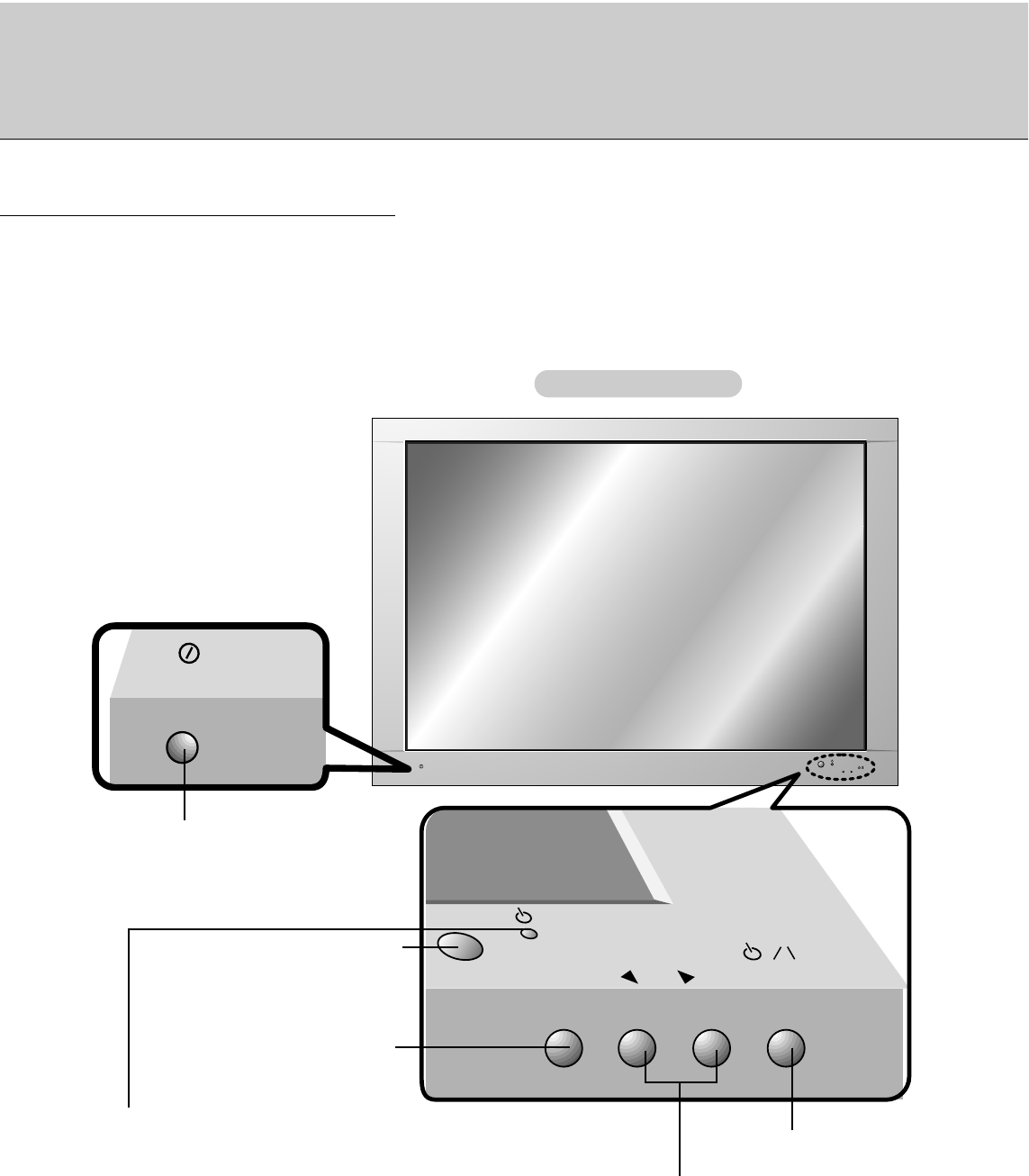
6
Monitor Controls
ON/OFF
VOLUME
INPUT
SELECT
ON/OFFINPUTVOLUME
SELECT
Main Power Button
Input Select Button
Remote Control Sensor
Power/Standby Indicator
Illuminates red in standby.
Illuminates green when the Monitor is turned on. Power Button
Volume (F,G) Button
Front Panel Controls
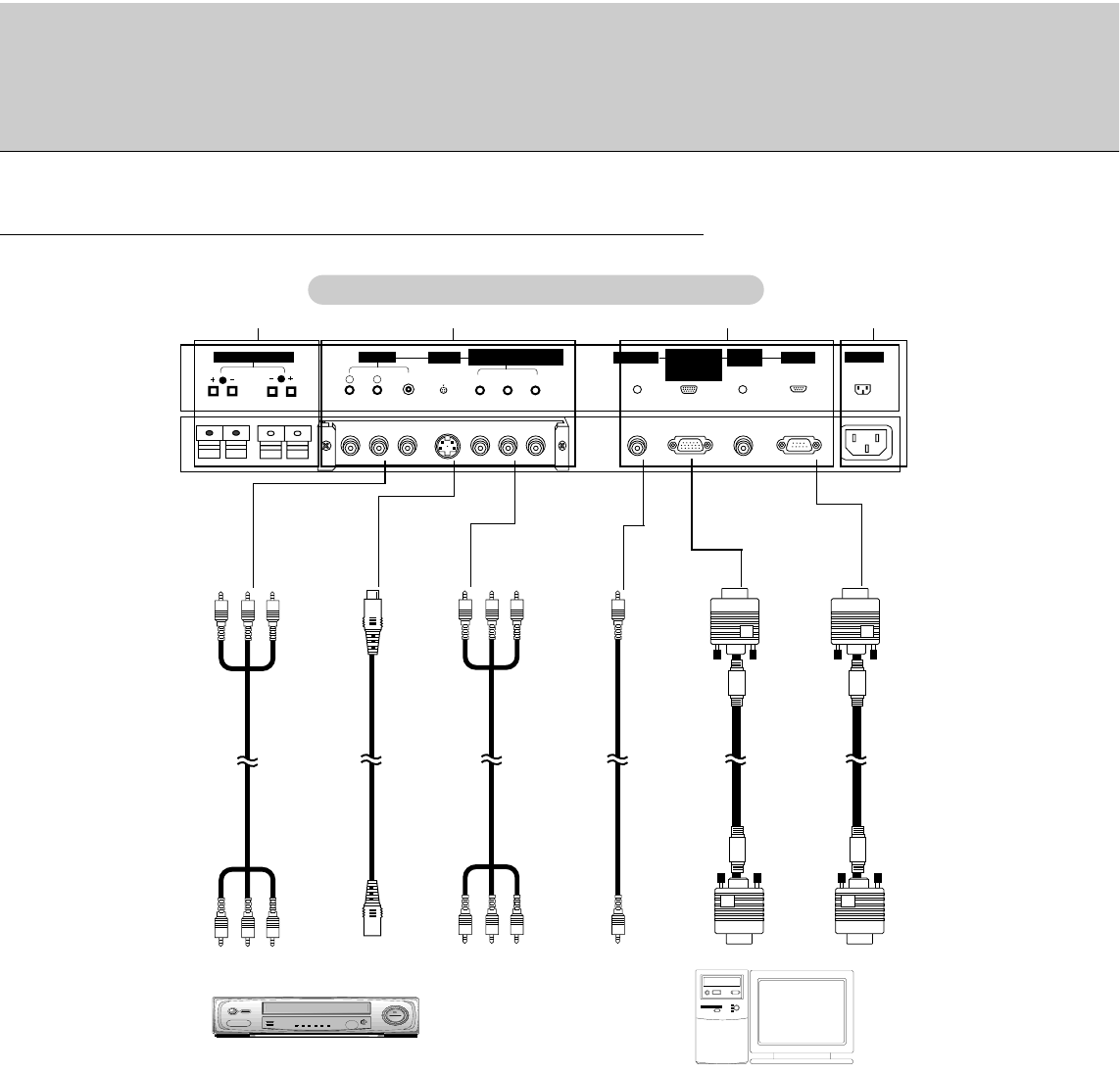
Connection to PC
Connection to AV Equipment
7
AC INPUT
AV INPUT
YP
B
P
R
(8Ω)
EXTERNAL SPEAKER
( )
( )
R
(MONO) VIDEO
R
AUDIO
L
COMPONENT(480i/480p/720p/1080i)
(DVD/DTV INPUT)
RS-232C
RGB-PC INPUT
AUDIO INPUT
(VGA/SVGA)
RGB-DTV INPUT
(480p/720p/1080i)
REMOTE
CONTROL
S-VIDEO
( )
( )
L
AV INPUT
COMPONENT
(480i/480p/720p/1080i)
(DVD/DTV INPUT)
S-VIDEO
INPUT AUDIO
INPUT
RGB-PC INPUT
(VGA/SVGA)
RGB-DTV INPUT
(480p/720p/1080i) RS-232C INPUT
Watching External Equipments
1. EXTERNAL SPEAKER (8 ohm output)
Connect to optional external speaker(s).
*For further information, refer to ‘Speaker & Speaker
Stand’manual.
2. AV INPUT JACKS
Connect audio/video out from external equipment to
these jacks
S-VIDEO JACKS
Connect video out from an S-VIDEO VCR to the S-VIDEO
input.
COMPONENT(480i/480p/720p/1080i)(DVD/DTV INPUT)
JACKS
3. AUDIO INPUT/
RGB-PC INPUT (VGA/SVGA)/
RGB-DTV INPUT (480p/720p/1080i) Jacks
Connect the monitor output jack of the PC or Digital set-
top box to this jack.
REMOTE CONTROL
Connect your wired remote control to remote control jack
of the monitor.
RS-232C IN Jack
Connect to the serial port on a PC.
4. POWER CORD SOCKET
This Monitor operates on an AC power. The voltage is
indicated on the Specifications page. Never attempt to
operate the Monitor on DC power
4
3
2
1
Note: All cables shown are not provided with the Monitor, except:
A D-sub 15 pin cable is supplied to connect the Monitor to a PC.
Monitor External Equipment Connection Panel

8
- When connecting the Monitor with external equipments, match the colors of connecting ports (Video - yellow, Audio(L) -
white, Audio(R) -red).
- If you have a mono VCR, connect the audio cable from the VCR to the AUDIO (L/MONO) input of the Monitor.
- If you connect an S-VIDEO VCR to the S-VIDEO input, the picture quality is improved; compared to connecting a regu-
lar VCR to the Video input.
- Avoid having a fixed image remain on the screen for a long period of time. Typically a frozen still picture from a VCR,
16:9 picture format is present; the fixed image may remain visible on the screen.
- To avoid picture noise (interference), leave an adequate distance between the VCR and monitor
1. Press INPUT SELECT button on the remote control and select Video.
(If connected to S-VIDEO, select the S-Video external input source.)
2. Insert a video tape into the VCR and press the PLAY button on the VCR. (See VCR owner’s manual)
- When connecting the monitor to an external source, match the colors of A/V input jacks on the monitor with the output
jacks on the audio/video equipment: Video = yellow, Audio (Left) = white, Audio (Right) = red.
1. Press INPUT SELECT button on the remote control to select Video.
2. Operate the corresponding external equipment. See external equipment operating guide.
- After subscribing to a cable TV service from a local provider and installing a converter, you can watch cable TV program-
ming. This monitor cannot display TV programming without a TV tuner device or cable TV converter box connected to the
monitor.
- For further information regarding cable TV service, contact your local cable TV service provider(s).
1. Press INPUT SELECT button on the remote control and select Video.
2. Tune to cable service provided channels using the cable box.
W
Watching VCR Setup
atching VCR Setup
W
Watching External
atching External A/V Source Setup
A/V Source Setup
W
Watching Cable
atching Cable TV Setup
TV Setup
•Component Input ports
You can get better picture quality if you con-
nect DVD player with component input ports
as below.
Component ports of the
Monitor Y PBPR
Video output ports
of DVD player
Y
Y
Y
Y
Pb
B-Y
Cb
PB
Pr
R-Y
Cr
PR
How to connect
Connect DVD video inputs to Y, PB, PRof COMPONENT
(480i/480p/720p/1080i) (DVD/DTV INPUT) or the single RGB-DTV
input for video connctions, depending on your DVD connectors. Then
make the corresponding audio connections and audio inputs to Audio
sockets of AUDIO INPUT.
How to use
1. Turn on the DVD player, and insert a DVD.
2. Use INPUT SELECT button on the remote control to select
Component. Refer to the DVD player's manual for operating instruc-
tions.
W
Watching DVD Setup
atching DVD Setup

9
- To enjoy vivid picture and sound, connect a PC to the Monitor.
- Avoid keeping a fixed image on the monitor’s screen for a long period of time. The fixed image may become permanent-
ly imprinted on the screen; use a screen saver when possible.
- Connect PC to the RGB-PC INPUT(VGA/SVGA) RGB-DTV INPUT(480p/720p/1080i) port of the Monitor: changing the
resolution output of PC accordingly.
- Synchronization input form; Separate
Setup Instructions to Connect a PC to your Monitor
- Set the video mode of PC to VGA/SVGA to obtain the best picture quality for the Monitor.
- If the resolution of PC is over SVGA, there will be no picture on the Monitor.
- Connect the signal cable from the monitor output port of the PC to the RGB-PC INPUT(VGA/SVGA) RGB-DTV INPUT
(480p/720p/1080i) port of the Monitor.
- Connect the audio cable from the PC to the Audio ports of the Monitor. (Audio cables not included with the Monitor)
- In case of using a sound card adjust PC sound properly.
- If the resolution of PC is over SVGA, connect to the RGB INPUT(VGA/SVGA) port of the Monitor after changing the res-
olution of PC under SVGA.
- If picture isn’t be displayed properly by connecting a non-standard PC, contact your dealer for more information.
- It maybe occur a picture noise.according to any contrast or brightness in PC mode. In this case, adjust contrast or bright-
ness level to get better picture quality.
PC Setup
1. Turn on the PC and apply power to the Monitor.
2. Turn on the display by pressing the POWER button on the Monitor’s remote control.
3. Use the INPUT SELECT button on the remote control to select the RGB input source.
3. Set the resolution output of the PC under SVGA (800x600).
Resolution
640x350
640x400
640x480
Horizontal
Frequency (KHz)
31.468
37.861
31.469
37.927
31.469
35.000
37.861
37.500
43.269
45.913
Vertical
Frequency (Hz)
70.09
85.08
70.08
85.03
59.94
66.66
72.80
75.00
85.00
90.03
Resolution
640x480
800x600
832x624
Horizontal
Frequency (KHz)
53.011
64.062
35.156
37.879
48.077
46.875
53.674
56.000
64.016
49.725
Vertical
Frequency (Hz)
100.04
120.00
56.25
60.31
72.18
75.00
85.06
90.00
100.00
74.55
- To watch digitally broadcast programs, purchase/connect a digital SET-TOP BOX.
How to connect a user-supplied Digital Set-Top Box
•You can use either the monitor’s Y, PB, PRof COMPONENT (480i/480p/720p/1080i) (DVD/DTV INPUT) or the single
RGB-DTV INPUT for video connections, depending on your set top box connectors. Then make the cprresponding audio
connectons.
•Connect DTV set-top box audio outputs to monitor AUDIO INPUT jacks.
How to use
1. Turn on the digital SET-TOP BOX. (Refer to the owner’s ,manual for the digital SET-TOP BOX.)
2. Press INPUT SELECT on the remote control to select Component.
W
Watching DTV Setup
atching DTV Setup
PC Setup
PC Setup
Monitor Display Specifications
Monitor Display Specifications
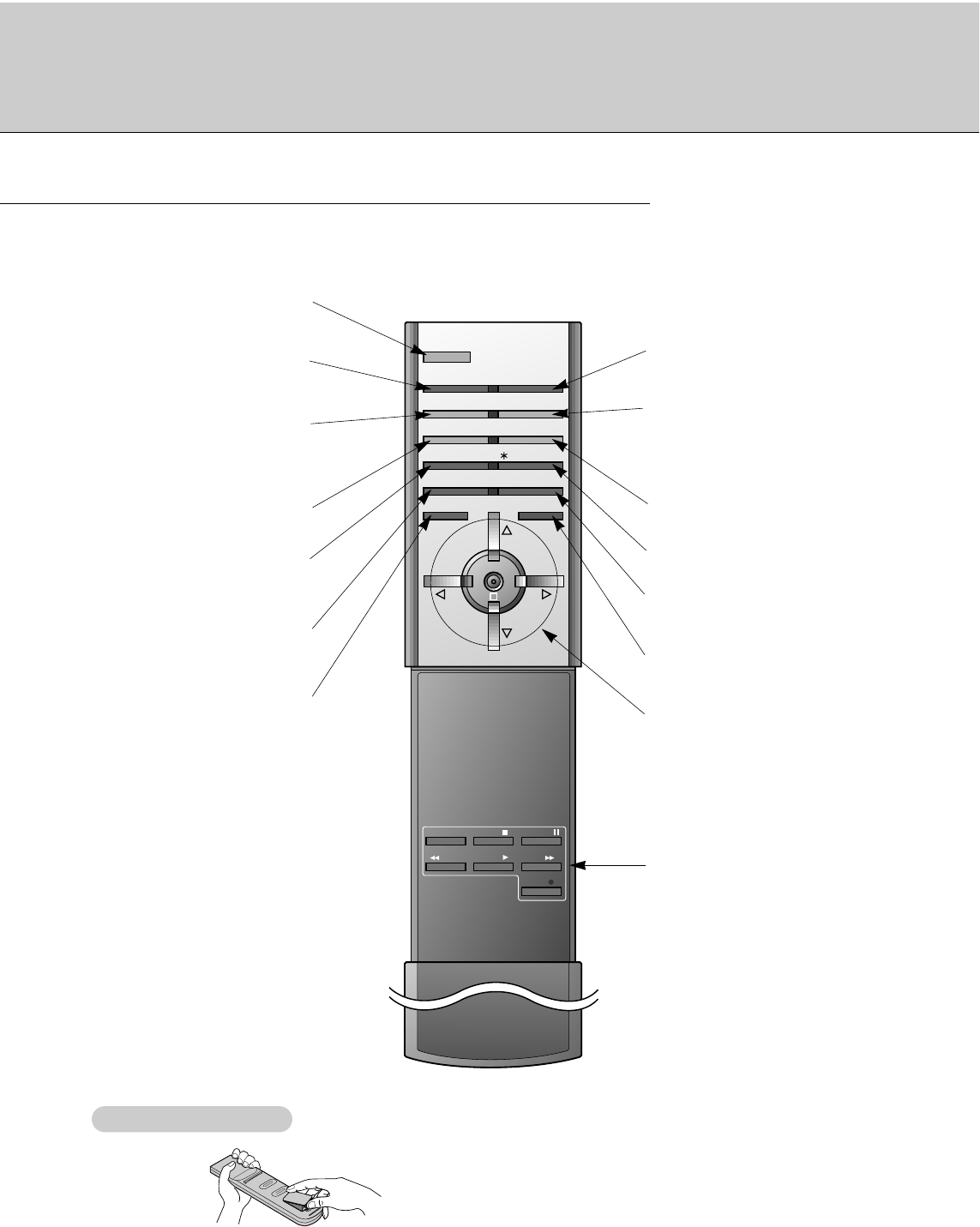
10
Remote Control Key Functions
- When using the remote control aim it at the remote control sensor of the Monitor.
POWER
SLEEP INPUT SELECT
PSM SSM
ARC STILL
PIP
/ TWIN PICTURE
PIP INPUT
MENU MUTE
OK
VOL
POWER STOP
PLAY FF
REC
REW
P/STILL
VOL
POSITION
POWER
Switches the Monitor on from
standby or off to standby.
SLEEP
Sets the sleep timer.
(Refer to p.17)
PSM
Adjusts the factory preset
picture according to the room.
(Refer to p.13)
ARC
Changes the picture format.
(Refer to p.16)
PIP
Switches the sub picture on or
off. (Refer to p.18)
PIP INPUT
Selects the input mode for the
sub picture.
MENU
Displays on screen menus
one by one.
VCR BUTTONS
Controls a LG video cassette
recorder.
OK
D / E
Selects a menu option.
F / G (Volume button)
Increases/decreases sound level.
Adjusts menu settings.
INPUT SELECT
Selects: Video, S-Video,
Component or RGB mode.
SSM
To select the sound appropriate to
your viewing program character:
Flat, Speech, Movie, Music, or
User. (Refer to p.14)
STILL
Freezes motion of the sub picture.
POSITION
relocates the sub picture in clock-
wise direction.
MUTE
Switches the sound on or off.
No function
•Open the battery compartment cover on the back side and
insert the batteries with correct polarity.
•Install two 1.5V alkaline batteries of AAA type. Don’t mix used
batteries with new batteries.
Installing Batteries
Installing Batteries
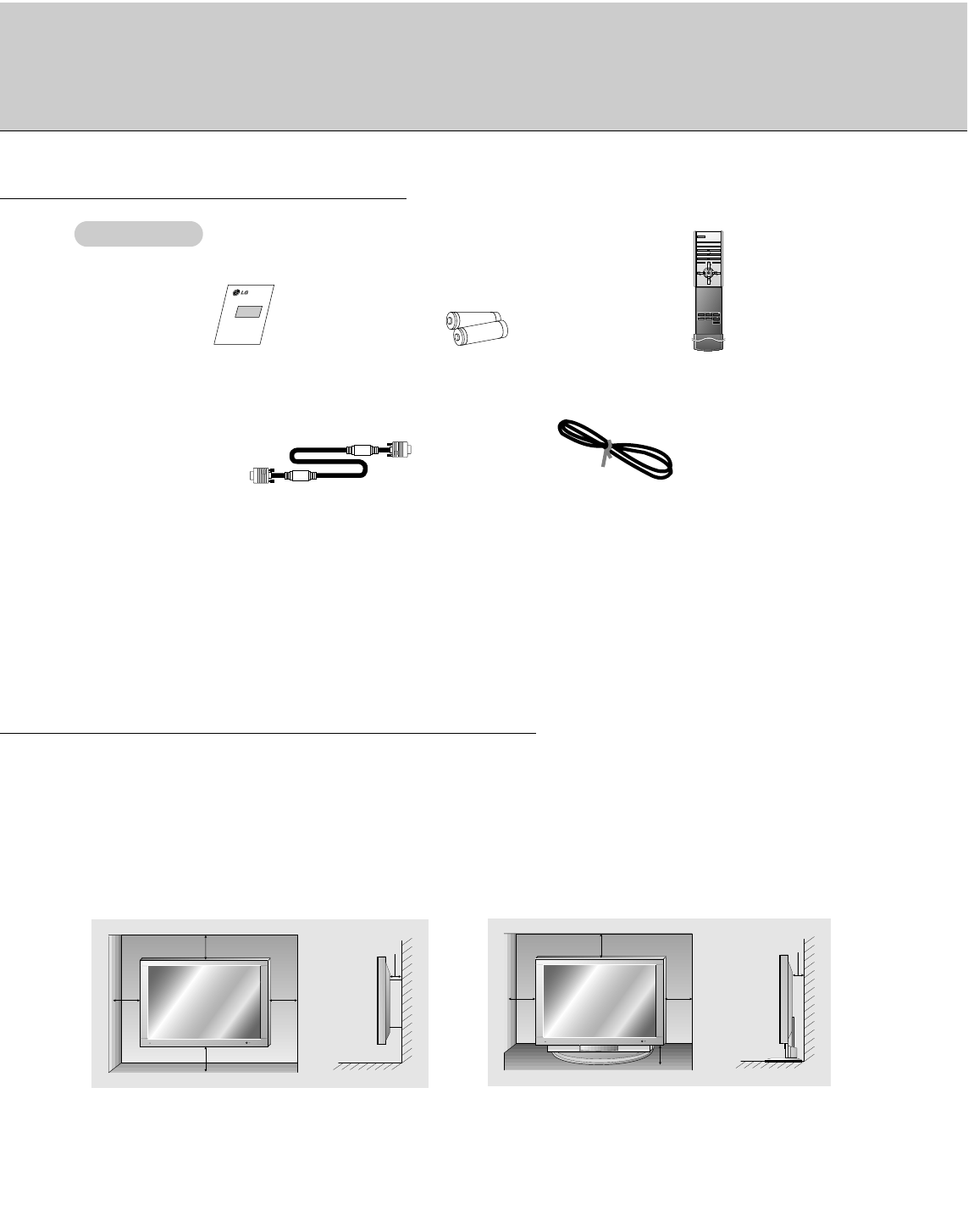
11
D-sub 15 pin cable
AS mark
LG TV
Owner’s Manual
1.5V
1.5V
Alkaline batteries
Power cord
POWER
SLEEP INPUT SELECT
PSM SSM
ARC STILL
PIP
/ TWIN PICTURE
PIP INPUT
MENU MUTE
OK
VOL
POWER STOP
PLAY FF
REC
REW
P/STILL
VOL
POSITION
Remote control handset
Monitor Installation Options
•The Monitor can be installed in various ways such such as on a wall, or on a desktop etc.
•Install this monitor only in a location where adequate ventilation is available.
•It is recommended that this product only be used at an altitude of less than 5250 feet (1600m) to get the best quality picture and
sound.
4inch
4inch
2.36inch
4inch
1.18inch
4inch
4inch
4inch4inch
1.18inch
To install as wall mounting type
Wall mount minimum allowable clearances for
adequate ventilation
To install as desktop type
Pedestal mount minimum allowable clearances for
adequate ventilation
Monitor overview
Accessories
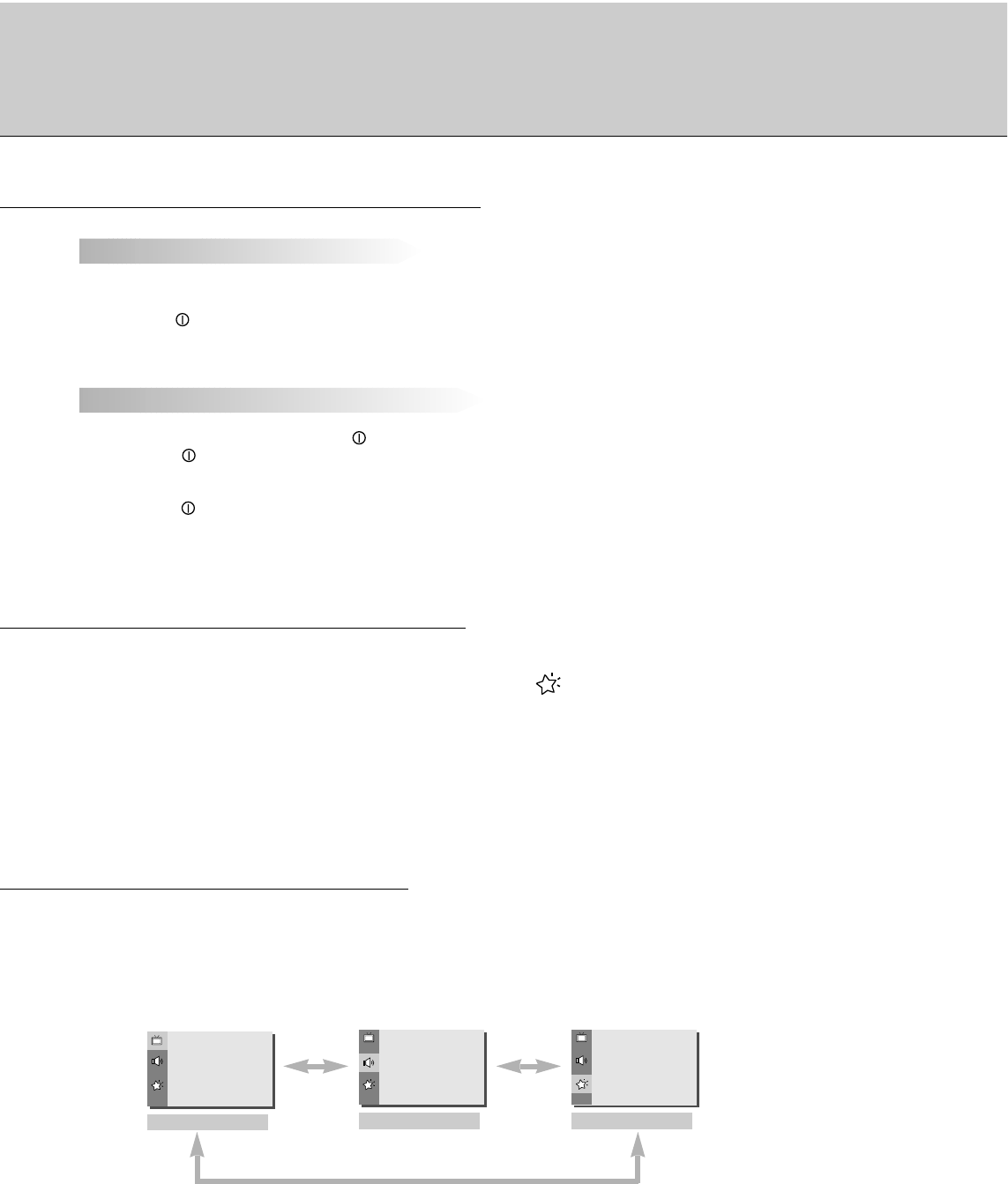
12
1. Press the MENU button.
2. Press the D/ Ebutton.
• Each time you press this button you can see menus shown below.
3. Press the Gbutton and then use D/ E/ F/ Gbutton to select a function you want to use.
• Press the OK button to exit.
Function checking
PSM G
Colour Temp. G
Contrast 100 G
Brightness 50 G
Colour 50 G
Sharpness 50 G
Tint 0 G
GOK
SSM G
AVL G
Treble 50 G
Bass 50 G
Balance 0 G
GOK
Language G
ARC G
Screen Adj. G
Orbiter G
White Wash G
PIP G
Transparency G
Set ID G
GOK
<Video menu> <Audio menu> <Special menu>
DE DE DE
Turning on the Monitor
Turning on the Monitor just after installation
Turning on the Monitor (power cord is still connected)
1. Connect power cord correctly.
2. Press the ON/OFF button on the Monitor. At this moment, the Monitor is switched to standby mode. Press the
INPUT SELECT button on the Monitor or press the POWER, INPUT SELECT button on the remote control and
then the Monitor will be switched on.
1. If the Monitor is turned off with the ON/OFF button on the Monitor
• Press the ON/OFF button on the Monitor to turn on the Monitor.
2. If the Monitor is turned off with the remote control and also the ON/OFF button on the Monitor
•Press the ON/OFF button on the Monitor and then press the INPUT SELECT button on the Monitor or press
the POWER, INPUT SELECT button on the remote control to turn on the Monitor.
Menu language setup
-The menus can be shown on the screen in the selected language. First select your language.
1. Press the MENU button and then use D/ Ebutton to select the menu.
2. Press the Gbutton and then use D/ Ebutton to select Language.
3. Press the Gbutton and then use D/ Ebutton to select your desired language.
From this point on, the on-screen display will be shown in the language of your choice.
4. Press the OK button.
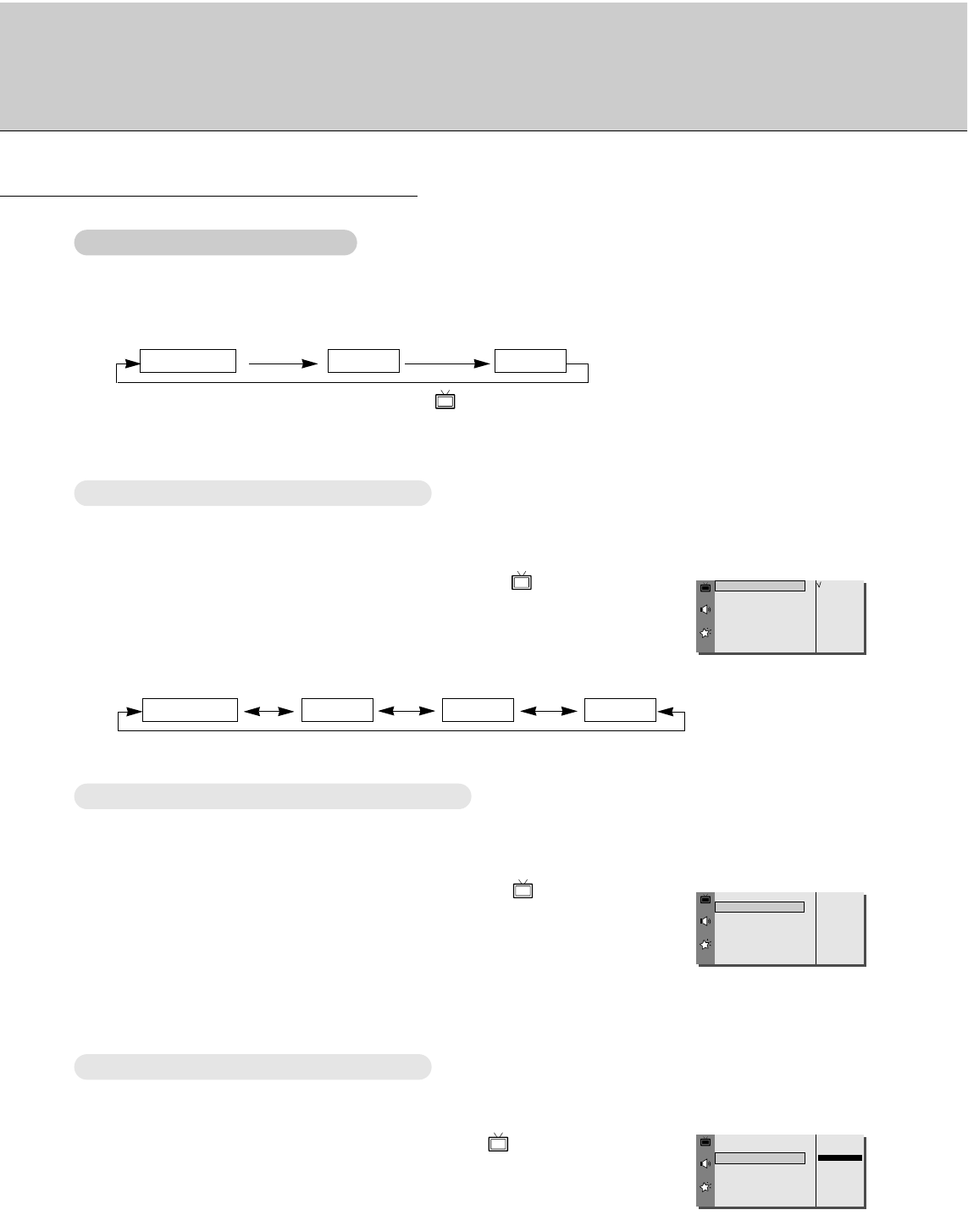
13
Video Menu Options
1. Press the PSM button to select the picture appearance setup option.
•Each press PSM button changes the screen display as shown below.
•You can also select Dynamic, Mild or User in the menu.
•The picture Dynamic and Mild are programmed for good picture reproduction at the factory and cannot be changed.
Dynamic Mild User
- This function adjusts the Monitor to the best picture appearance
- This function is not available in PC mode and PIP.
CSM G
Red G
Green G
Blue G
Normal
Cool
Warm
User
CSM
- Adjustments also affect the color temperature if other input sources. Readjust color temperature for PC input
(RGB) if necessary.
- To initial values (reset to default settings), select the ‘Normal’option.
1. Press the MENU button and then use D/ Ebutton to select the menu.
2. Press the Gbutton and then use D/ Ebutton to select Colour Temp..
3. Press the Gbutton and then use D/ Ebutton to select CSM.
4. Press the Gbutton and then use D/ Ebutton to select the desired color temperature.
• Each press of D/ Ebutton changes the screen display as shown below.
5. Press the OK button.
Normal Cool Warm User
- You should be adjust colour temperature in PC mode again although color temperature is adjusted in other input source.
- To initialize adjusted value, select ‘0’in Red, Green and Blue.
1. Press the MENU button and then use D/ Ebutton to select the menu.
2. Press the Gbutton and then use D/ Ebutton to select the Colour Temp..
3. Press the Gbutton and then use D/ Ebutton to select a color.
4. Press the Gbutton and then use F/ Gbutton to make appropriate adjustments.
• The adjustment range of Red, Green and Blue is -50~+50.
5. Press the OK button.
CSM G
Red G
Green G
Blue G
0
Red
PSM (Picture Status Memory)
PSM (Picture Status Memory)
Adjusting
Adjusting Auto Color Control
Auto Color Control
Manual Color
Manual Color T
Temperature Control (User option)
emperature Control (User option)
- You can adjust picture contrast, brightness, colour, sharpness and tint to the levels you prefer.
- PIP settings are not adjustable.
1. Press the MENU button and then D/ Ebutton to select the menu.
2. Press the Gbutton and then D/ Ebutton to select the desired picture item.
3. Press the Gbutton and then F/ Gbutton to make appropriate adjustments.
4. Press the OK button.
PSM G
Colour Temp. G
Contrast 100 G
Brightness 50 G
Colour 50 G
Sharpness 50 G
Tint 0 G
Contrast 100
Manual Picture Control (User Option)
Manual Picture Control (User Option)
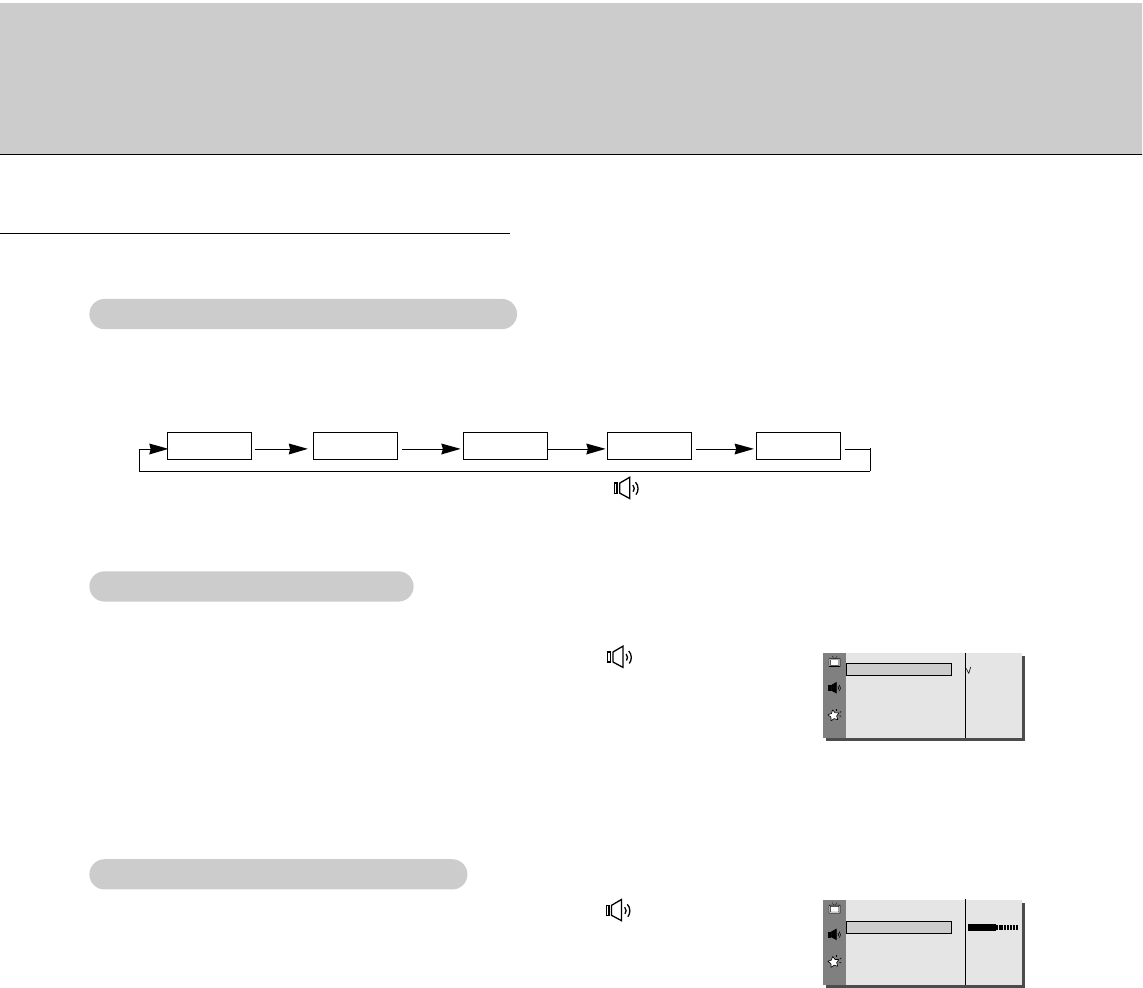
14
Audio Menu Options
1. Press the SSM button to select the picture appearance setup.
1. Press the MENU button and then use D/ Ebutton to select the menu.
2. Press the Gbutton and then use D/ Ebutton to select the desired sound item.
3. Press the Gbutton and then use F/ Gbutton to make appropriate adjustments.
4. Press the MENU button.
•You can also select Flat, Speech, Movie, Music or User in the menu.
Flat Speech Movie Music User
- This function lets you enjoy the best sound without any special adjustment because the Monitor automatically
selects the appropriate sound option based on the program content.
- This feature maintains an equal volume level; even if you change channels.
1. Press the MENU button and then use D/ Ebutton to select the menu.
2. Press the Gbutton and then use D/ Ebutton to select AVL.
3. Press the Gbutton and then use D/ Ebutton to select On or Off.
4. Press the MENU button.
SSM G
AVL G
Treble 50 G
Bass 50 G
Balance 0 G
Treble 50
SSM G
AVL G
Treble 50 G
Bass 50 G
Balance 0 G
On
Off
AVL
SSM (Sound Status Memory)
SSM (Sound Status Memory)
A
AVL
VL (Auto V
(Auto Volume Leveler)
olume Leveler)
Adjusting Sound (Manual Setting)
Adjusting Sound (Manual Setting)
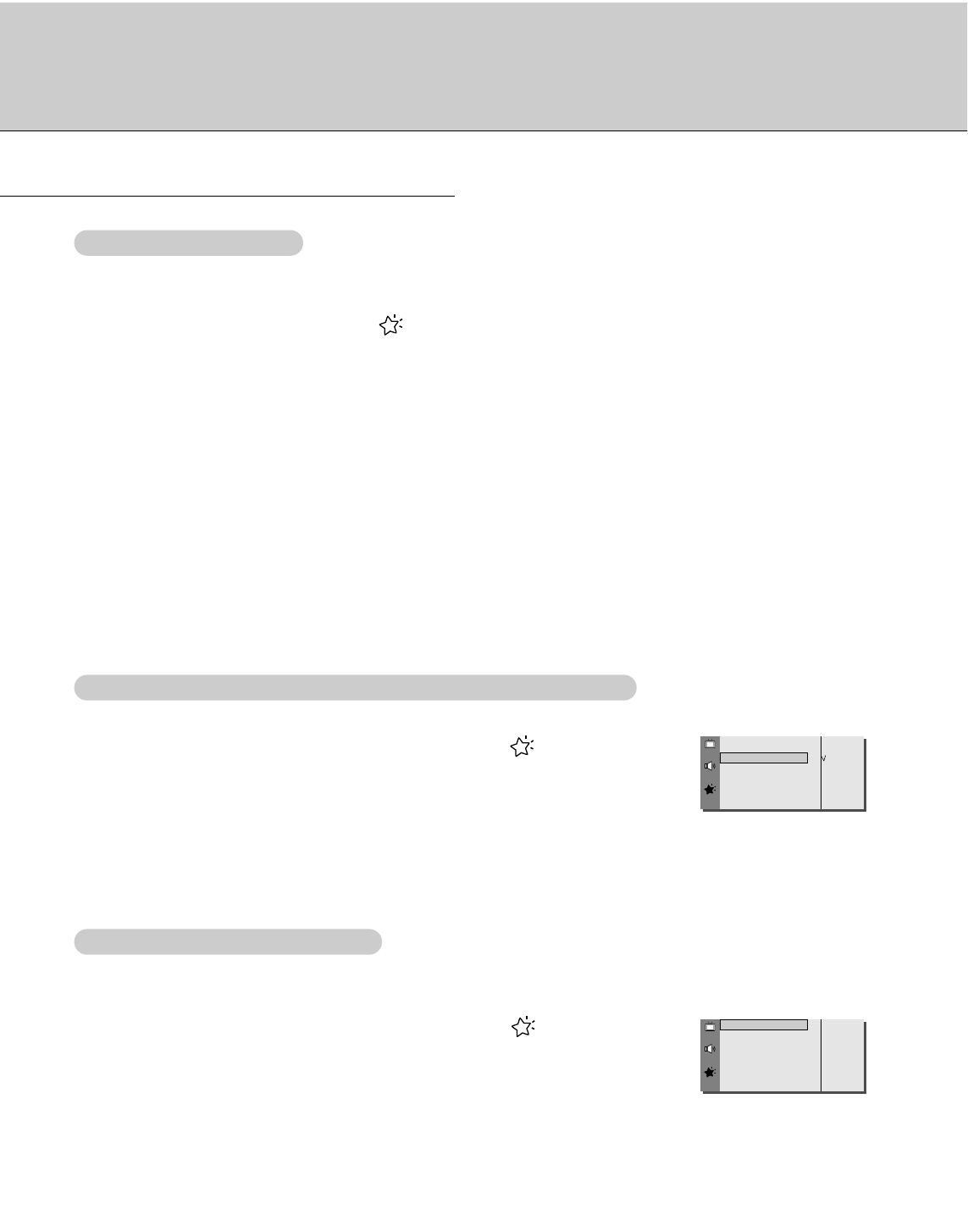
15
Special Menu Options
- If 16:9 is on the screen for a long time, that fixed image may remain visible.
- Don’t display 16:9 picture format on screen above 10 hours continuously.
- You are available to 4:3 in RGB-PC (Except 800x600) mode.
- You can also select 4:3, 16:9 or Zoom in the menu.
1. Press the ARC button to select a desired picture format.
• 4:3
-This picture format is 4 to 3 of general monitor.
• 16:9
- You can enjoy the cinema (the picture format of 16:9) or general monitor program through the 16:9 mode.
- The screen 16:9 is viewed just like that but the screen 4:3 is magnified to the left and right so that the screen 16:9 is full.
- A RGB-DTV (720p/1080i) and Component (720p/1080i) source can only use the 16:9 screen aspect ratio.
• Zoom
- You can enjoy the cinema in a vast screen through the Zoom mode. The screen 4:3 is magnified to the upper/lower sides
so that the screen 16:9 is full. The bottom and top of the picture may be lost.
- You are available to Zoom in RGB-PC (800x600).
- A RGB-DTV (720p/1080i) and Component (720p/1080i) source can’t use the Zoom screen aspect ratio.
- Use this function to correct jittering or picture instability while viewing a video tape.
1. Press the MENU button and then use D/ Ebutton to select the menu.
2. Press the Gbutton and then use D/ Ebutton to select Screen adj..
3. Press the Gbutton and then use D/ Ebutton to to select TV or VCR.
• Select the VCR option if watching a VCR.
• Select the TV option for other equipment.(Except VCR)
4. Press the OK button.
- Automatically adjusts picture position and minimizes image shaking.
- Although the image is still not correct, your Monitor is functioning properly but needs further adjustment.
1. Press the MENU button and then use D/ Ebutton to select the menu.
2. Press the Gbutton and then use D/ Ebutton to select Screen adj..
3. Press the Gbutton and then use D/ Ebutton to select Auto-configure.
4. Press the Gbutton.
• When Auto-configure has finished, OK will be shown on screen.
• If the position of the image is still not correct, try Auto adjustment again.
5. If picture needs to be adjusted more after Auto adjustment in RGB, you can adjust the
V-Position, H-Position and Phase.
Language G
ARC G
Screen Adj. G
Orbiter G
White Wash G
PIP G
Transparency G
Set ID G
TV
VCR
Screen Adj.
Auto-Configure G
V-Position G
H-Position G
Phase G
Reset G
To set
Auto-Configure
Setting Picture Format
Setting Picture Format
Screen
Screen Adjustments (V
Adjustments (Video, S-video and Component 480i mode only)
ideo, S-video and Component 480i mode only)
Auto
Auto Adjustments (RGB mode only)
Adjustments (RGB mode only)
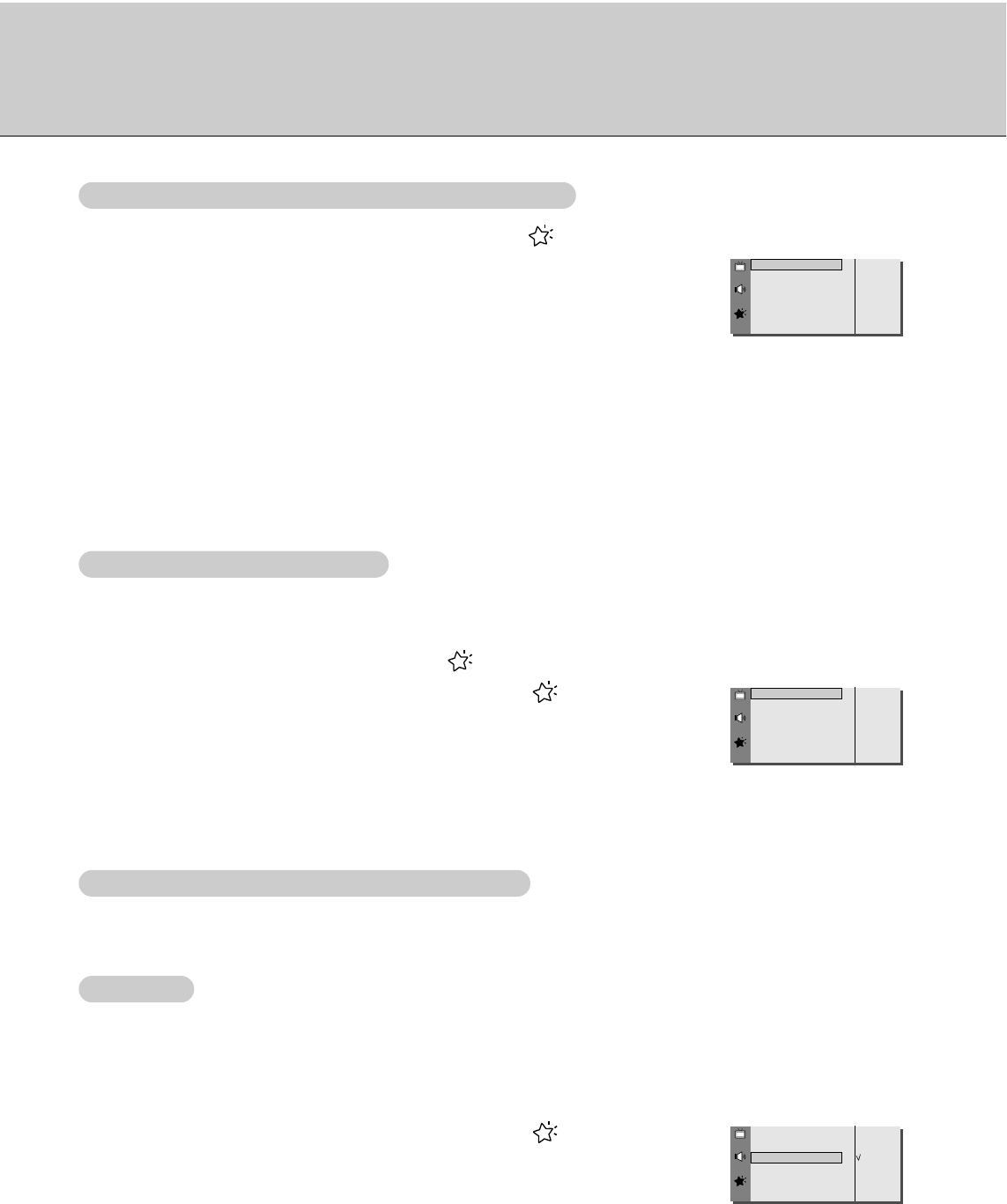
16
•To initialize the adjusted value, select Reset with the D/ Ebutton and then press the Gbutton.
1. Press the MENU button and then use D/ Ebutton to select the menu.
2. Press the Gbutton and then use D/ Ebutton to select Screen Adj..
3. Press the Gbutton and then use D/ Ebutton to select V-Position or H-Position.
• Select V-Position for vertical position adjustment.
• Select H-Position for horizontal position adjustment.
4. Press the Gbutton and then use F/ Gbutton to adjust until you get desired horizontal
or vertical position and then press the OK button.
• Based on the input mode, the adjustment range of V-Position or H-Position may
change.
• Based on the input signal, the position of the picture may not change even though
you have adjusted the horizontal or vertical position with this function.
Adjusting phase (RGB mode only)
- If the picture isn’t clear after auto adjustment and especially if characters are still jittery, adjust the picture
phase manually.
- When watching PIP, Screen option is not available in menu.
1. Press the MENU button and then use D/ Ebutton to select the menu.
2. Press the Gbutton and then use D/ Ebutton to select Phase.
3. Press the Gbutton and then use F/ Gbutton to adjust phase.
• The adjustment range of Phase is 0 ~ 63.
4. Press the OK button.
- Avoid keeping a fixed image remain on the Monitor's screen for a long period of time. A frozen still picture from a
PC/video game set displayed on the screen for prolonged periods will result in an image ghost remaining even
when you change the image.
- To avoid a permanent image on the screen, the screen will move every 2 minutes.
- The Orbiter feature may help prevent ghost images. However, it is best not to allow any fixed image to remain on
the screen.
1. Press the MENU button and then use D/ Ebutton to select the menu.
2. Press the Gbutton and then use D/ Ebutton to select Orbiter.
3. Press the Gbutton and then use D/ Ebutton to select On or Off.
4. Press the OK button.
Language G
ARC G
Screen Adj. G
Orbiter G
White Wash G
PIP G
Transparency G
Set ID G
On
Off
Orbiter
Auto-Configure G
V-Position G
H-Position G
Phase G
Reset G
To Set
Auto-Configure
Auto-Configure G
V-Position G
H-Position G
Phase G
Reset G
To Set
Auto-Configure
Adjusting Horizontal / V
Adjusting Horizontal / Vertical Position (RGB mode only)
ertical Position (RGB mode only)
Adjusting Phase (RGB mode only)
Adjusting Phase (RGB mode only)
Initializing (Reset to Factory value (RGB mode only)
Initializing (Reset to Factory value (RGB mode only)
Orbiter
Orbiter
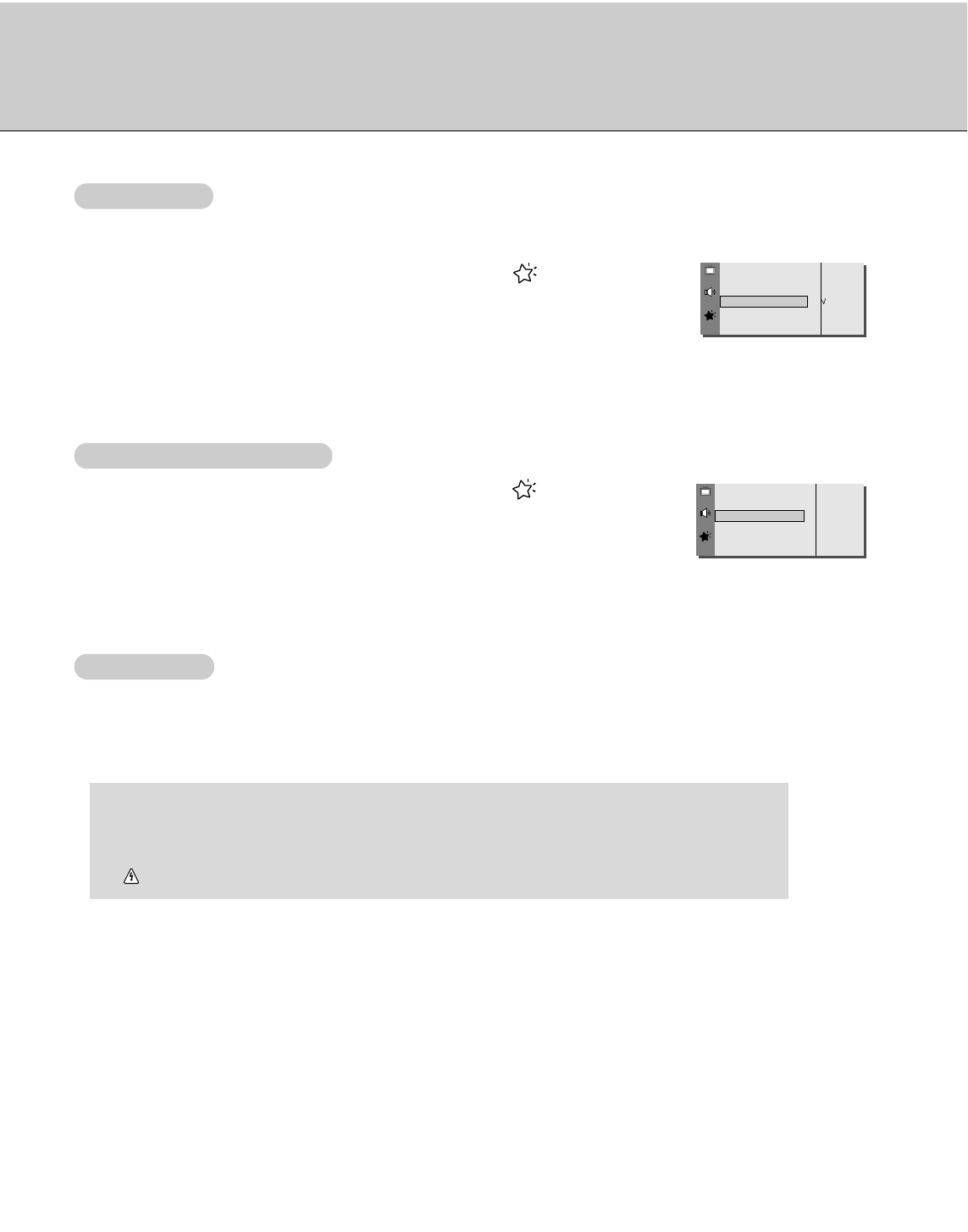
17
- Sleep timer turns the monitor off at the preset time.
- Press the SLEEP button to select the number of minutes. The display F--- Gwill appear on the screen, followed
by 10,20, 30, 60, 90, 120, 180 and 240. The timer begins to count down from the number of minutes selected.
- When the sleep time you want is displayed on the screen, don’t press the sleep button. After 20 seconds, the
screen display disappears and sleep time is set.
1. Press the MENU button and then use D/ Ebutton to select the menu.
2. Press the Gbutton and then use D/ Ebutton to select Transparency.
3. Press the Gbutton and then use F/ Gbutton to adjust OSD transparency.
• The adjustment range of Transparency is 0 ~ 5.
4Press the OK button.
Language G
ARC G
Screen G
Transparency G
PIP/DW G
Set ID G
Colour Temp. G
5
Transparency
- White Wash removes permanent images from the screen.
- Set White Wash ‘On’until fixed image disappears.
1. Press the MENU button and then use D/ Ebutton to select the menu.
2. Press the Gbutton and then use D/ Ebutton to select White Wash.
3. Press the Gbutton and then use D/ Ebutton to select On or Off.
• When you select ON, the screen changes to white.
4. Press the OK button.
Language G
ARC G
Screen Adj. G
Orbiter G
White Wash G
PIP G
Transparency G
Set ID G
On
Off
White Wash
White W
White Wash
ash
Adjusting OSD
Adjusting OSD T
Transparency
ransparency
Sleep
Sleep T
Timer
imer
a. To check the remaining sleep time, press the SLEEP or OK button just once.
b. If you turn the Monitor off after setting the sleep timer, the setting is erased. The sleep timer will then have to
be set again.
c. To release sleep time setting, press the SLEEP or F/ Gbutton repeatedly to select F--- G.
d. ‘ rr1’is displayed, one minute before the Monitor is due to switch off.
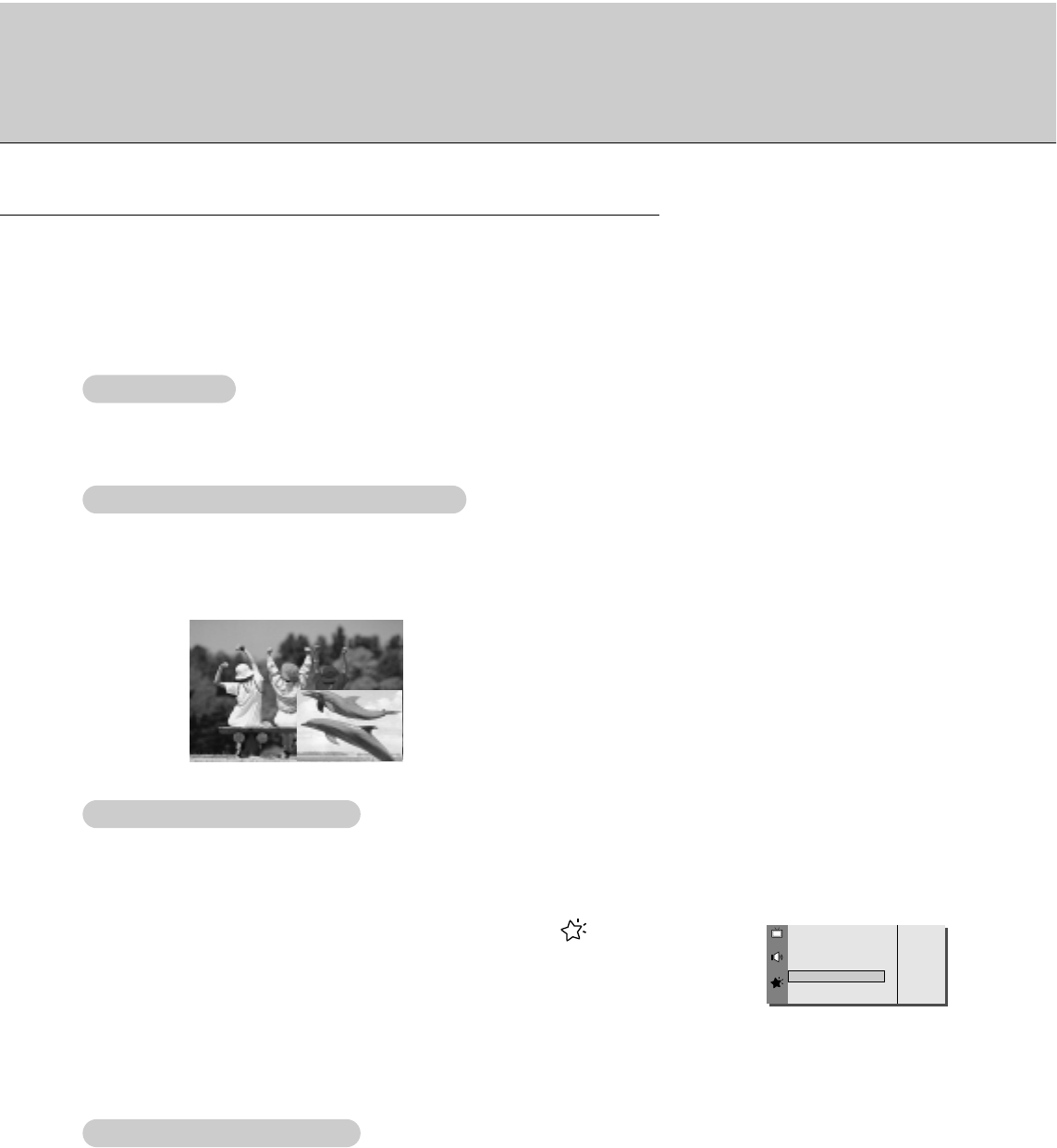
18
- PIP lets you view 2 different inputs (sources) on your monitor screen at the same time. One source will be large,
and the other source will show a smaller inset image.
- Select RGB input source before pressing PIP
- This function works only in the following resolution;
Component (480p, 720p, 1080i), RGB-PC 640x480, 800x600 (only in Vertical frequency 60 Hz)
- With PIP active, not all picture formats can be used for the main/sub picture.
PIP (Picture-in-Picture) Feature
Press the PIP button to show the sub picture.
•Press the PIP button again to turn PIP off.
Press the POSITION button in PIP mode.
•Each press of the POSITION button will change the position of the sub picture on the screen clockwise.
Press the PIP INPUT button in PIP mode.
•Each time you press PIP INPUT button, you toggle Video, S-Video and Component.
Component source only works in 480i mode.
- Select RGB input source before pressing PIP.
- To use this function, connect PC video port to RGB-PC INPUT(VGA/SVGA) socket and connect PC audio port
to AUDIO INPUT.
-Sound Select is always selected Sound[M] regardless of prior sound choice.
1. Press the MENU button and then use D/ Ebutton to select the menu.
2. Press the Gbutton and then use D/ Ebutton to select PIP.
3. Press the Gbutton and then use D/ Ebutton to select Sound Select.
4. Press the Gbutton and then use D/ Eto select main image sound (Sound[M]) or PIP
(inset image) sound (Sound[S]).
5. Press the OK button.
Language G
ARC G
Screen Adj. G
Orbiter G
White Wash G
PIP G
Transparency G
Set ID G
G
To Set
PIP
W
Watching PIP
atching PIP
Selecting a Input Signal Source for the PIP
Selecting a Input Signal Source for the PIP
Selecting PIP
Selecting PIP Sound Options
Sound Options
Moving the Sub Picture
Moving the Sub Picture
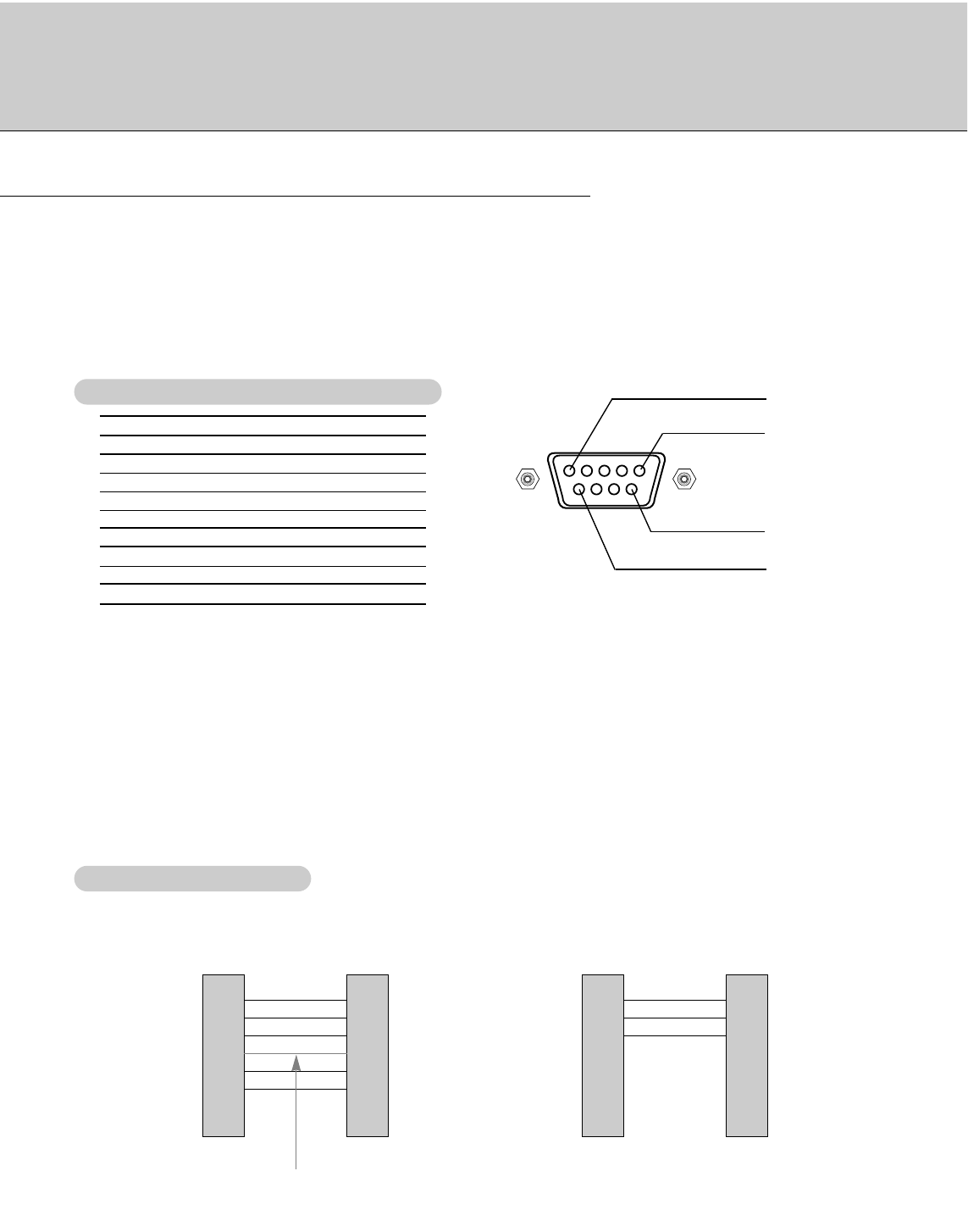
19
No. Pin name
1 No connection
2 RXD (Receive data)
3 TXD (Transmit data)
4 DTR (DTE side ready)
5 GND
6 DSR (DCE side ready)
7 RTS (Ready to send)
8 CTS (Clear to send)
9 No Connection
1
5
6
9
2
3
5
4
6
7
8
RXD
TXD
GND
DTR
DSR
RTS
CTS
TXD
RXD
GND
DSR
DTR
CTS
RTS
PC
7-wire configuration
(Standard RS-232C cable)
DB 9
Control line
3
2
5
6
4
8
7
PDP
DB 9
2
3
5
4
6
7
8
RXD
TXD
GND
DTR
DSR
RTS
CTS
TXD
RXD
GND
DTR
DSR
RTS
CTS
PC
3-wire configuration
(Not standard)
DB 9
3
2
5
4
6
7
8
PDP
DB 9
* Use a null modem cable.
Wire the 7-Wire cable so that each pair of data lines cross between the two devices. These data line pairs are RXD (Receive
data) and TXD (Transmit data), DTR (DTE side ready) and DSR (DCE side ready), and RTS (Ready to send) and CTS
(Clear to send).
When using the 3-Wire cable connected to RXD, TXD and GND; Pin No. 4 (DTR) and Pin No. 6 (DSR) must be connected
to the monitor. (The cable must be disconnected from the Monitor to be able to use the remote control and Monitor front
panel controls.)
* With the RS-232 input connected, the Monitor cannot be controlled by both an external control device and the remote con-
trol at the same time. The Monitor can only be controlled by either the remote control or the external control device.
External Control Device Setup
- Connect the RS-232C input jack to an external control device (such as a computer or an A/V control system) and control
the Monitor’s functions externally.
- Connect the serial port of the control device to the RS-232C jack on the Monitor back panel.
- RS-232C connection cables are not supplied with the Monitor.
- The Monitor remote control and front panel controls (except main power) will not be functional if the Monitor is controlled
by a PC computer or other external device.
- When you connect a control (RS-232C) cable to this monitor, use control cable attached the ferrite core. If you do not do
this, this monitor will not conform to mandatory CISPR22 (EN55022) standards.
T
Type of connector; D-Sub 9-pin male
ype of connector; D-Sub 9-pin male
RS-232C configurations
RS-232C configurations
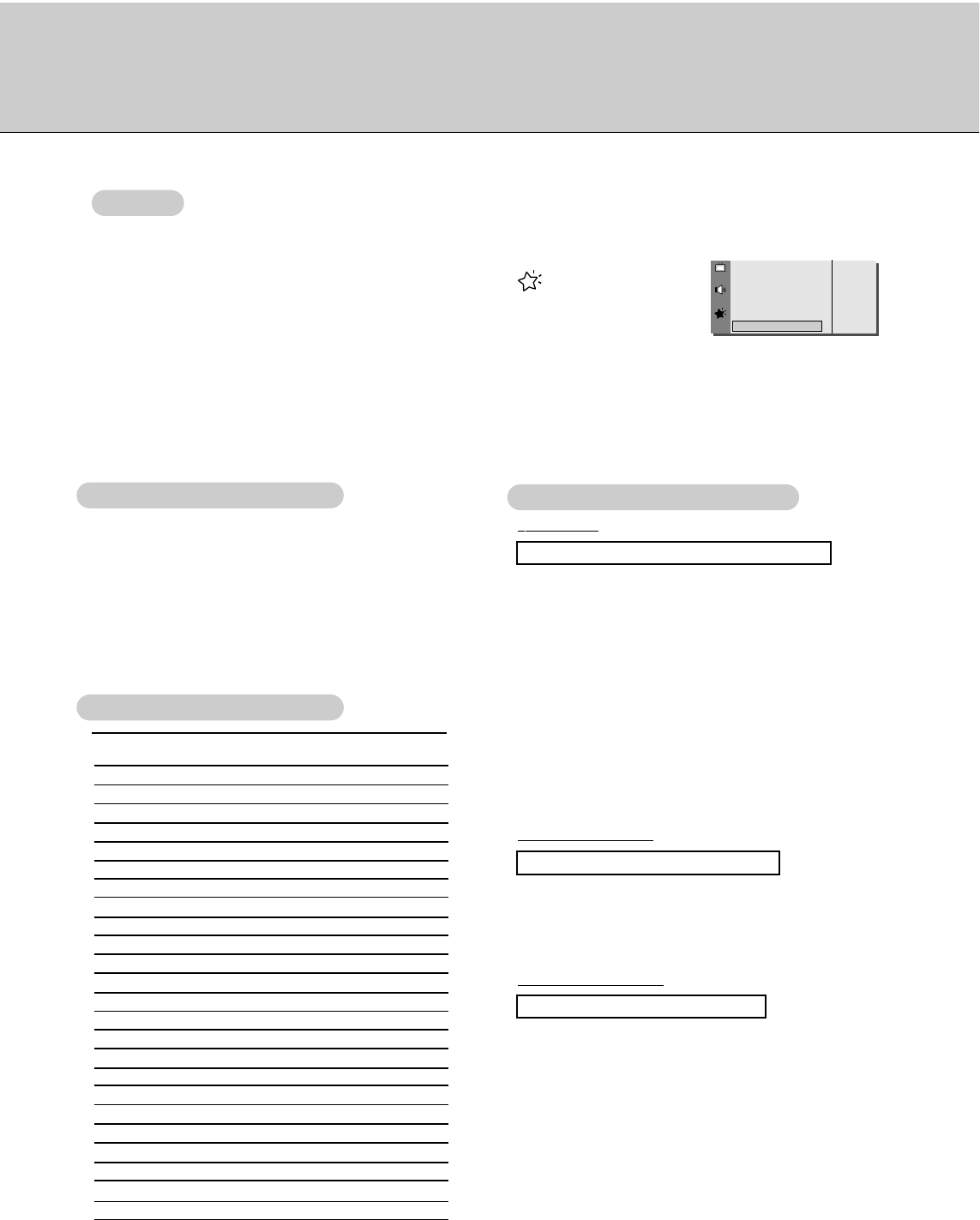
20
•Baud rate : 115200 bps (UART)
•Data length : 8 bits
•Parity : None
•Stop bit : 1 bit
•Communication code : ASCII code
* If the command interval is interrupted for more than 4
seconds, only Command 1 will be recognized.
Be careful when using the power command.
- The RS-232C input jack is used to control the Monitor’s functions using an external contro device.
Transmission
* [Command 1] : k
* [Command 2] : To control PDP set.
* [Set ID] : You can adjust the set ID to choose
desired monitor ID number in special
menu.
Adjustment range is 1 ~ 99.
When selecting Set ID ‘0’, every con-
nected PDP set is controlled.
* [DATA] : To transmit command data.
Transmit ‘FF’data to read status of
command.
* [Cr] : Carriage Return
ASCII code ‘0x0D’
* [ ] : ASCII code ‘space (0x20)’
[Command1][Command2][ ][Set ID][ ][Data][Cr]
OK Acknowledgement
01. Power k a 00 ~ 01
02. Input Select k b 00 ~ 03
03. Aspect Ratio k c 00 ~ 02
04. Screen mute k d 00 ~ 01
05. Volume mute k e 00 ~ 01
06. Volume control k f 00 ~ 64
07. Contrast k g 00 ~ 64
08. Brightness k h 00 ~ 64
09. Color k i 00 ~ 64
10. Tint k j 00 ~ 64
11. Sharpness k k 00 ~ 64
12. OSD select k l 00 ~ 01
13.
Remote control lock mode
k m 00 ~ 01
14. PIP k n 00 ~ 01
15. Sound input select k p 00 ~ 01
16. PIP position k q 00 ~ 03
17. Treble k r 00 ~ 64
18. Bass k s 00 ~ 64
19. Balance k t 00 ~ 64
20. Color temperature k u 00 ~ 03
21. R adjustment k v 00 ~ 64
22. Green adjustment k w 00 ~ 64
23. Blue adjustment k $ 00 ~ 64
24. PIP input source k y 00 ~ 03
* The Monitor transmits ACK (acknowledgement) based
on this format when receiving normal data. At this
time, if the data is data read mode, it indicates present
status data. If the data is data write mode, it returns
the data of the PC computer.
[Command2][ ][Set ID][ ][OK][Data][x]
Error Acknowledgement
* The Monitor transmits ACK (acknowledgement) based
on this format when receiving abnormal data from
non-viable functions or communication errors.
[Command2][ ][Set ID][ ][NG][Data][x]
- Use this function to specify a monitor ID number.
1. Press the MENU button and then use D/ Ebutton to select the menu.
2. Press the Gbutton and then use D/ Ebutton to select Set ID.
3. Use the F/ Gbutton to adjust Set ID to choose the desired monitor ID number.
• The adjustment range of Set ID is 1 ~ 99.
• Refer to ‘Real Data Mapping 1’. See page 22.
Language G
ARC G
Screen Adj. G
Orbiter G
White Wash G
PIP G
Transparency G
Set ID G
1
Set ID
Set ID
Set ID
Communication Parameters
Communication Parameters T
Transmission/Receiving Protocol
ransmission/Receiving Protocol
Command Reference List
Command Reference List
COMMAND 1 COMMAND 2 DATA
(Hexadecimal)
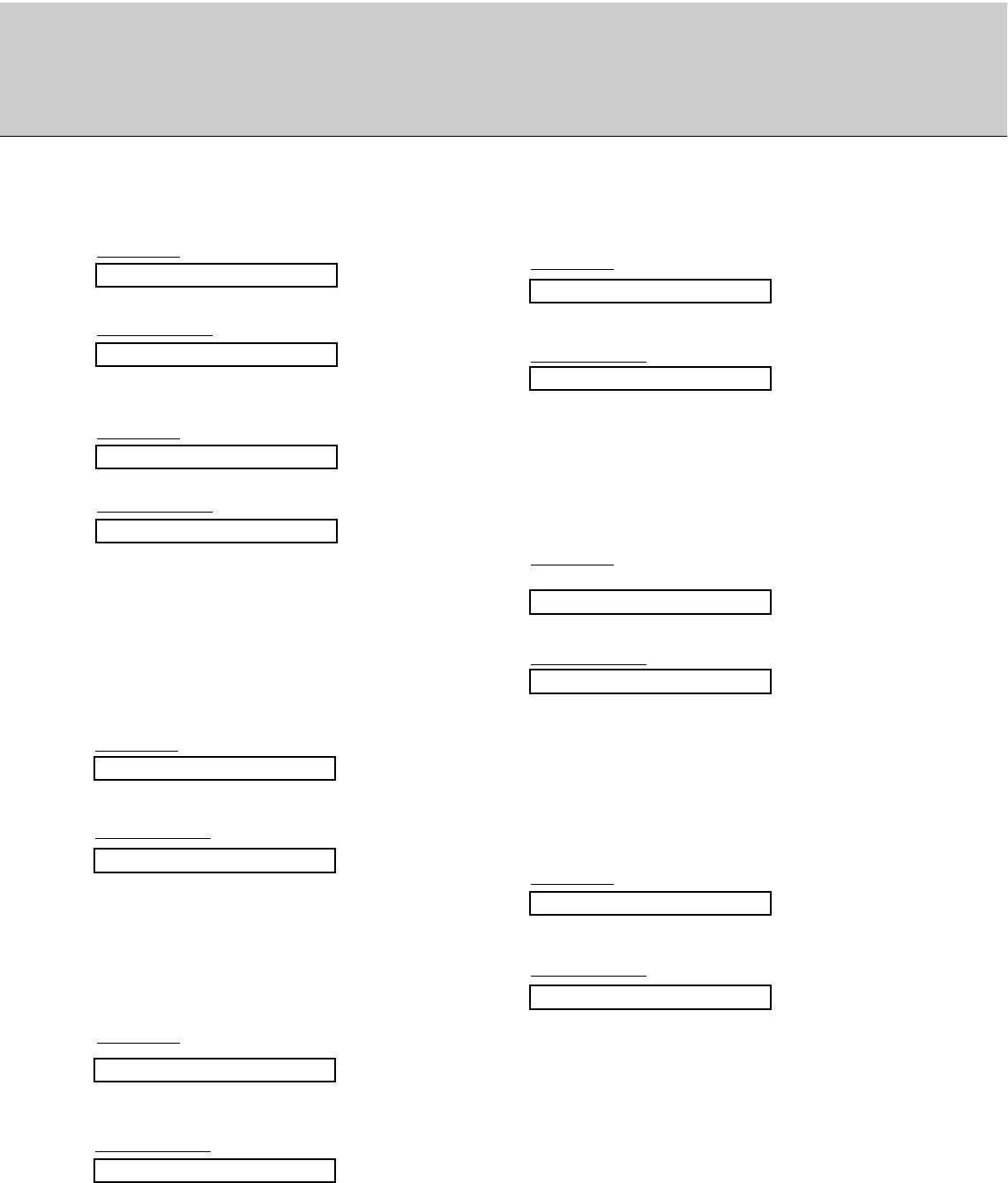
21
06. Volume control (Command:f)
GTo adjust volume.
You can also adjust volume with the volume buttons
on remote control.
Transmission
Data Min : 00 ~ Max : 64
* Refer to ‘Real data mapping1’.
[k][f][ ][Set ID][ ][Data][Cr]
Acknowledgement
Data Min : 00 ~ Max : 64
[f][ ][Set ID][ ][OK][Data][x]
03. Aspect Ratio (Command:c) (Main picture format)
GTo adjust the screen format.
You can also adjust the screen format using the ARC
(Aspect Ratio Control) button on remote control or in
the Special menu.
Transmission
Data 0 : Wide screen (16:9)
1 : Normal screen (4:3)
2 : Full screen (Zoom)
[k][c][ ][Set ID][ ][Data][Cr]
Acknowledgement
Data 0 : Wide screen (16:9)
1 : Normal screen (4:3)
2 : Full screen (Zoom)
[c][ ][Set ID][ ][OK][Data][x]
04. Screen mute (Command:d)
GTo select screen mute on/off.
Transmission
Data 0 : Screen mute on (Picture off)
1 : Screen mute off (Picture on)
[k][d][ ][Set ID][ ][Data][Cr]
Acknowledgement
Data 0 : Screen mute on (Picture off)
1 : Screen mute off (Picture on)
[d][ ][Set ID][ ][OK][Data][x]
02. Input select (Command:b) (Main picture input)
GTo select input source for the Monitor.
You can also select an input source using the INPUT
SELECT button on the Monitor's remote control.
Transmission
Data 0 : RGB
1 : Component 2 : Video
3 : S-Video
Data 0 : RGB
1 : Component 2 : Video
3 : S-Video
[k][b][ ][Set ID][ ][Data][Cr]
Acknowledgement
[b][ ][Set ID][ ][OK][Data][x]
01. Power (Command:a)
GTo control Power On/Off of the Monitor.
Transmission
Data 0 : Power Off 1 : Power On
Data 0 : Power Off 1 : Power On
Data 0 : Power Off 1 : Power On
Data 0 : Power Off 1 : Power On
[k][a][ ][Set ID][ ][Data][Cr]
Acknowledgement
[a][ ][Set ID][ ][OK][Data][x]
GTo show Power On/Off.
Transmission
[k][a][ ][Set ID][ ][FF][Cr]
Acknowledgement
* In like manner, if other functions transmit ‘FF’data
based on this format, Acknowledgement data feed
back presents status about each function.
[a][ ][Set ID][ ][OK][Data][x]
05. Volume mute (Command:e)
GTo control volume mute on/off.
You can also adjust mute using the MUTE button on
remote control.
Transmission
Data 0 : Volume mute on (Volume off)
1 : Volume mute off (Volume on)
[k][e][ ][Set ID][ ][Data][Cr]
Acknowledgement
Data 0 : Volume mute on (Volume off)
1 : Volume mute off (Volume on)
[e][ ][Set ID][ ][OK][Data][x]
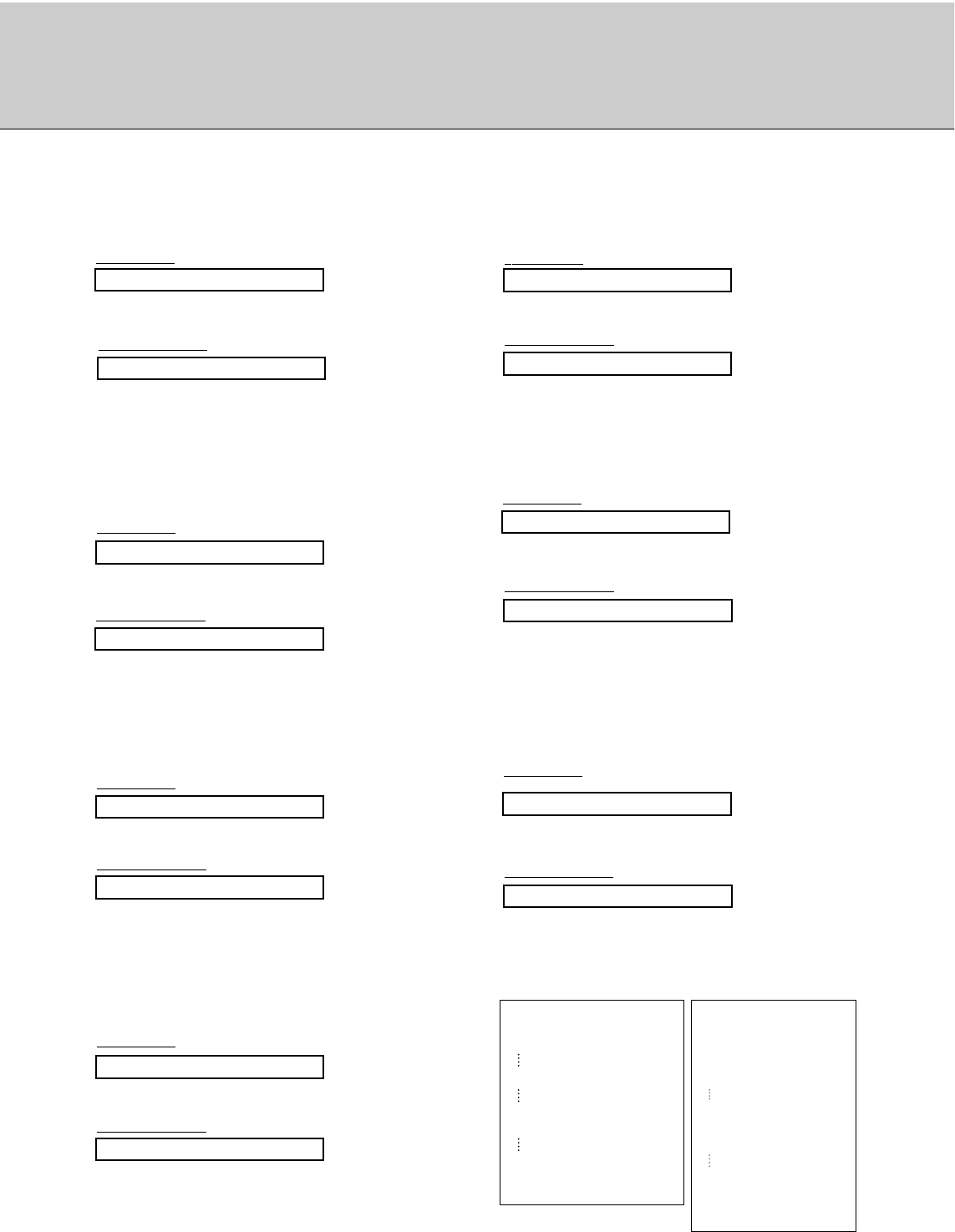
22
12. OSD select (Command:l)
GTo select OSD (On Screen Display) on/off.
Transmission
Data 0 : OSD off
1 : OSD on
[k][l][ ][Set ID][ ][Data][Cr]
Acknowledgement
Data 0 : OSD off
1 : OSD on
[l][ ][Set ID][ ][OK][Data][x]
13. remote control lock mode (Command:m)
GTo lock the front panel controls on the monitor and
remote control.
Transmission
Data 0 : off
1 : on
[k][m][ ][Set ID][ ][Data][Cr]
Acknowledgement
Data 0 : off
1 : on
* In not use the remote control, you can set this mode.
[m][ ][Set ID][ ][OK][Data][x]
08. Brightness (Command:h)
GTo adjust screen brightness.
You can also adjust brightness in the Video menu.
Transmission
Data Min : 00 ~ Max : 64
* Refer to ‘Real data mapping1’as shown below.
[k][h][ ][Set ID][ ][Data][Cr]
Acknowledgement
Data Min : 00 ~ Max : 64
[h][ ][Set ID][ ][OK][Data][x]
* Real data mapping 1
0 : Step 0
A : Step 10 (SET ID 10)
F : Step 15 (SET ID 15)
10 : Step 16 (SET ID 16)
64 : Step 100
* Real data mapping 2
0 : -10
5: -9
A: -8
2D: -1
32: 0
37: +1
5F: +9
64: +10
09. Color (Command:i)
GTo adjust the screen color.
You can also adjust color in the Video menu.
Transmission
Data Min : 00 ~ Max : 64
* Refer to ‘Real data mapping1’as shown below.
[k][i][ ][Set ID][ ][Data][Cr]
Acknowledgement
Data Min : 00 ~ Max : 64
[i][ ][Set ID][ ][OK][Data][x]
10. Tint (Command:j)
GTo adjust the screen tint.
You can also adjust tint in the Video menu.
Transmission
Data Red : 00 ~ Green : 64
* Refer to ‘Real data mapping1’as shown right.
[k][j][ ][Set ID][ ][Data][Cr]
Acknowledgement
Data Red : 00 ~ Green : 64
[j][ ][Set ID][ ][OK][Data][x]
11. Sharpness (Command:k)
GTo adjust the screen sharpness.
You can also adjust sharpness in the Video menu.
Transmission
Data Min : 00 ~ Max : 64
* Refer to ‘Real data mapping1’as shown below.
[k][k][ ][Set ID][ ][Data][Cr]
Acknowledgement
Data Min : 00 ~ Max : 64
[k][ ][Set ID][ ][OK][Data][x]
07. Contrast (Command:g)
GTo adjust screen contrast.
You can also adjust contrast in the Video menu.
Transmission
Data Min : 00 ~ Max : 64
* Refer to ‘Real data mapping1’.
[k][g][ ][Set ID][ ][Data][Cr]
Acknowledgement
Data Min : 00 ~ Max : 64
[g][ ][Set ID][ ][OK][Data][x]
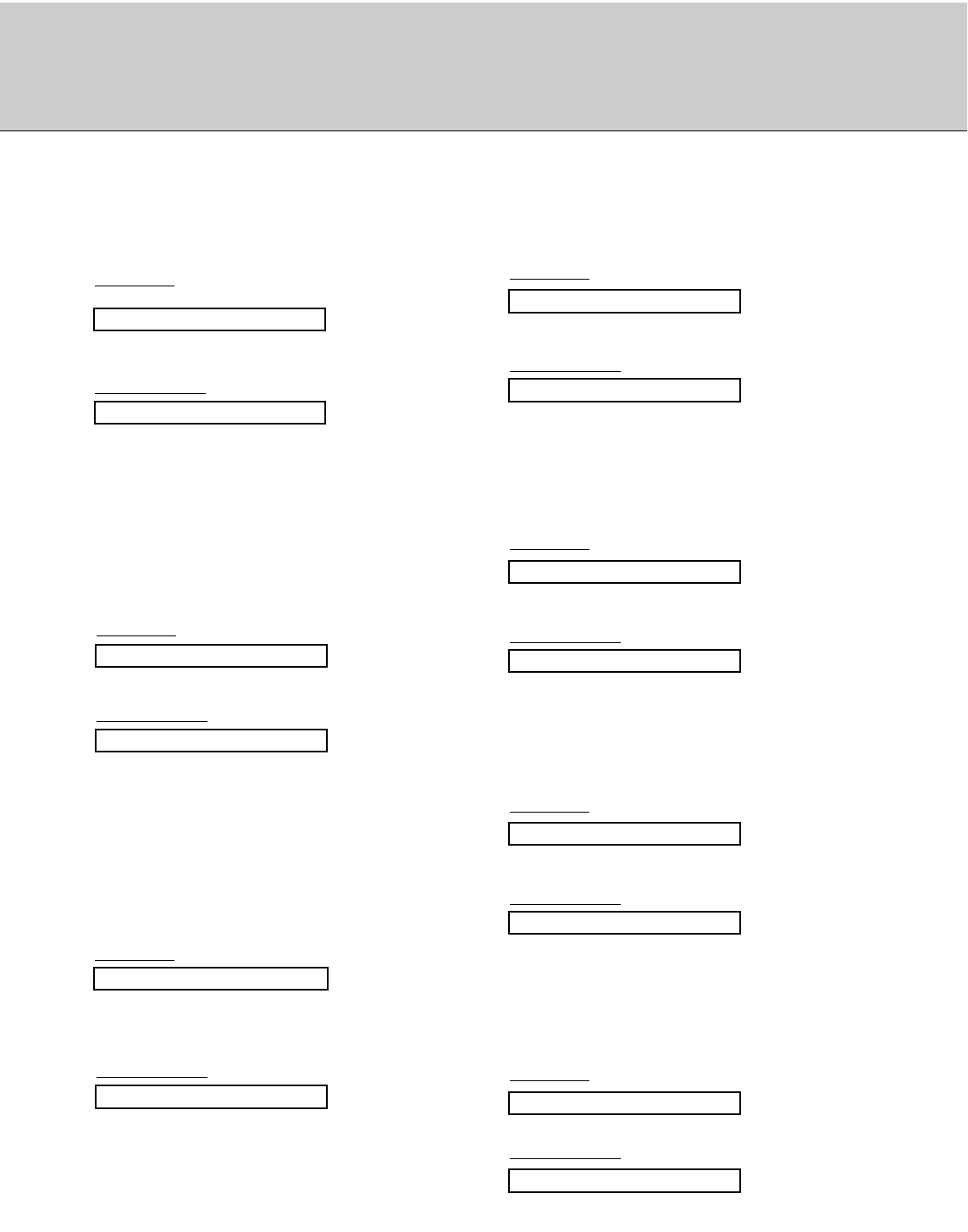
23
17. Treble (Command:r)
GTo adjust treble.
You can also adjust treble in the Audio menu
Transmission
Data Min : 00 ~ Max : 64
* Refer to ‘Real data mapping1’. See page 22.
[k][r][ ][Set ID][ ][Data][Cr]
Acknowledgement
Data Min : 00 ~ Max : 64
[r][ ][Set ID][ ][OK][Data][x]
18. Bass (Command:s)
GTo adjust bass.
You can also adjust bass in the Sound menu.
Transmission
Data Min : 00 ~ Max : 64
* Refer to ‘Real data mapping1’. See page 22.
[k][s][ ][Set ID][ ][Data][Cr]
Acknowledgement
Data Min : 00 ~ Max : 64
[s][ ][Set ID][ ][OK][Data][x]
19. Balance (Command:t)
GTo adjust balance.
You can also adjust balance in the Sound menu.
Transmission
Data Min : 00 ~ Max : 64
* Refer to ‘Real data mapping1’. See page 22.
[k][t][ ][Set ID][ ][Data][Cr]
Acknowledgement
Data Min : 00 ~ Max : 64
[t][ ][Set ID][ ][OK][Data][x]
20. Color Temperature (Command:u)
GTo adjust Color Temperature.
You can also adjust CSM in the Video menu.
Transmission
Data o: Normal 1: Cool 2: Warm 3: User
Data o: Normal 1: Cool 2: Warm 3: User
[k][u][ ][Set ID][ ][Data][Cr]
Acknowledgement
[u][ ][Set ID][ ][OK][Data][x]
16. PIP Position (Command:q)
GTo select sub picture position for PIP.
You can also adjust the sub picture position using the
POSITION on the remote control or in the Special
menu.
Transmission
Data 0 : Right down on screen
1 : Left down on screen
2 : Left up on screen
3 : Right up on screen
[k][q][ ][Set ID][ ][Data][Cr]
Acknowledgement
Data 0 : Right down on screen
1 : Left down on screen
2 : Left up on screen
3 : Right up on screen
[q][ ][Set ID][ ][OK][Data][x]
15. SoundInput Select (Command:p)
GTo select main or sub(inset) sound for PIP picture.
You can also select sound in PIP on the Special
menu.
Transmission
[k][p][ ][Set ID][ ][Data][Cr]
Acknowledgement
Data 0 : Main picture sound
1 : Sub picture sound
Data 0 : Main picture sound
1 : Sub picture sound
[p][ ][Set ID][ ][OK][Data][x]
14. PIP (Command:n)
GTo control the PIP (Picture In picture).
You can also control the PIP using the PIP button on
the remote control or in the Special menu.
Transmission
Data 0 : PIP off
1 : PIP on
[k][n][ ][Set ID][ ][Data][Cr]
Acknowledgement
Data 0 : PIP off
1 : PIP on
[n][ ][Set ID][ ][OK][Data][x]
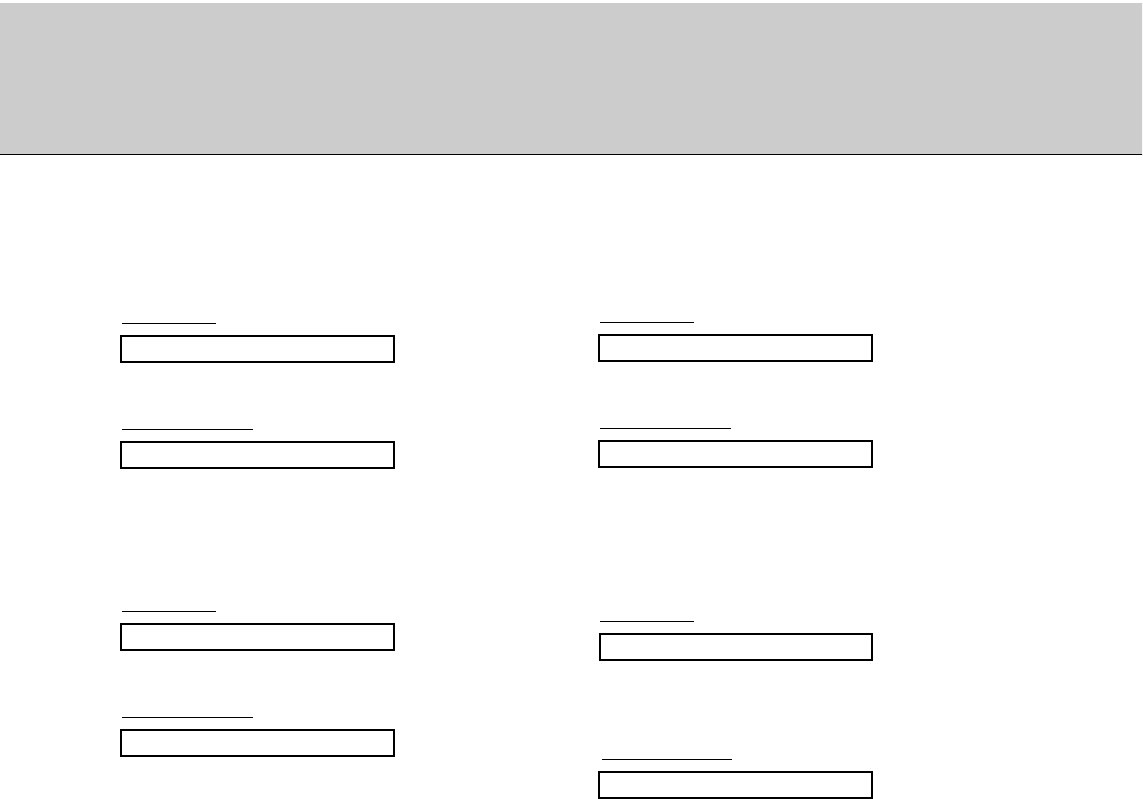
24
24. PIP input select (Command:y)
G To select input source for sub picture in PIP mode.
Transmission
Data 1 : Component
2 : Video
3 : S-Video
Data 1 : Component
2 : Video
3 : S-Video
[k][y][ ][Set ID][ ][Data][Cr]
Acknowledgement
[y][ ][Set ID][ ][OK][Data][x]
21. Red Adjustment (Command:v)
GTo adjust red in color temperature.
Transmission
Data Min : 00 ~ Max : 64
* Refer to ‘Real data mapping2’. See page 22.
Data Min : 00 ~ Max : 64
[k][v][ ][Set ID][ ][Data][Cr]
Acknowledgement
[v][ ][Set ID][ ][OK][Data][x]
22. Green Adjustment (Command:w)
GTo adjust green in green temperature.
Transmission
Data Min : 00 ~ Max : 64
* Refer to ‘Real data mapping2’. See page 22.
Data Min : 00 ~ Max : 64
[k][w][ ][Set ID][ ][Data][Cr]
Acknowledgement
[w][ ][Set ID][ ][OK][Data][x]
23. Blue Adjustment (Command:$)
GTo adjust blue in green temperature.
Transmission
Data Min : 00 ~ Max : 64
* Refer to ‘Real data mapping2’. See page 22.
Data Min : 00 ~ Max : 64
[k][$][ ][Set ID][ ][Data][Cr]
Acknowledgement
[$][ ][Set ID][ ][OK][Data][x]
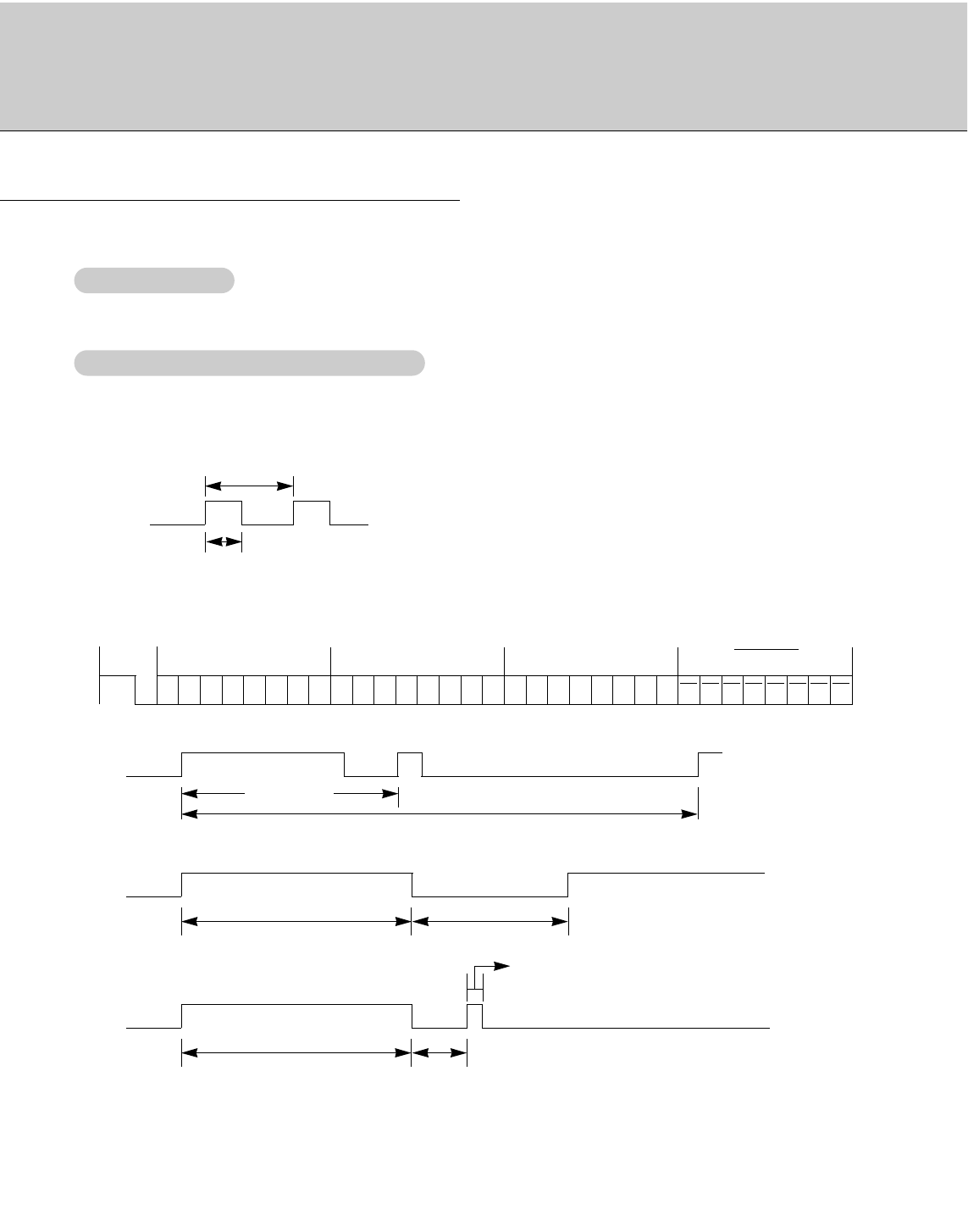
25
IR CODE (NEC format)
G Connect your wired remote control to remote control jack of the monitor.
G Output waveform
Single pulse, modulated with 37.917KHz signal at 455KHz
G Configuration of flame
G Repeat code
G Lead code
• 1st flame
Low
custom code
Lead
code High
custom code Data code Data code
TC
Tf
T1
C0
Carrier frequency
FCAR = 1/TC= fOSC/12
Duty ratio = T1/TC= 1/3
• Repeat flame
C1 C2 C3 C4 C5 C6 C7 C0 C1 C2 C3 C4 C5 C6 C7 D0 D1 D2 D3 D4 D5 D6 D7 D0 D1 D2 D3 D4 D5 D6 D7
Repeat code
9 ms 4.5 ms
0.55 ms
9 ms
2.25 ms
How to connect
How to connect
Remote Control IR Code (NEC Format)
Remote Control IR Code (NEC Format)
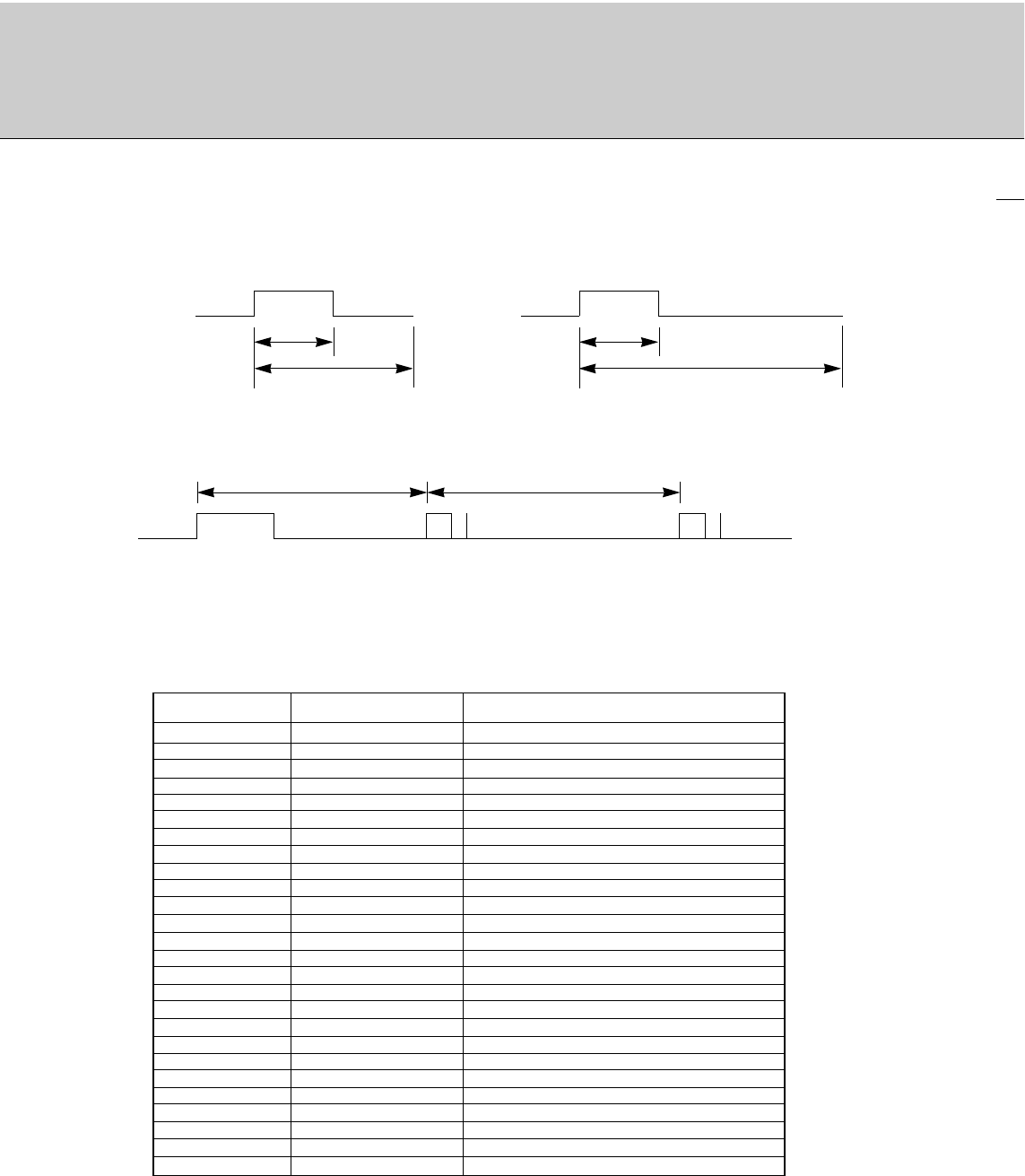
26
UP (D)
DOWN (E)
VOL+ (G)
VOL- (F)
POWER
POWER ON
SYSTEM OFF
MUTE
INPUT SELECT
RGB
VIDEO
S-VIDEO
COMPONENT
SLEEP
OK (Á)
MENU
SSM
PSM
PIP
PIP INPUT
(PIP)POSITION
STILL
ARC
ARC (16: 9)
ARC (4 : 3)
ARC (ZOOM)
00H
01H
02H
03H
08H
C4H
C5H
09H
0BH
98H
5AH
51H
BFH
0EH
1BH or 44H
42H
47H
4DH
60H
61H
62H
65H or BCH
79H
77H
76H
AFH
R/C Button
R/C Button
R/C Button
R/C Button
R/C Button (Power On/Off)
Discrete (Only Power On)
Discrete (Only System Off)
R/C Button
R/C Button
Discrete (Input RGB & Power On)
Discrete (Input VIDEO & Power On)
Discrete (Input S-VIDEO & Power On)
Discrete (Input COMPONENT & Power On)
R/C Button
R/C Button
R/C Button
R/C Button
R/C Button
R/C Button
R/C Button
R/C Button
R/C Button
R/C Button
Discrete (Only 16:9 mode)
Discrete (Only 4:3 mode)
Discrete (Only ZOOM mode)
Code (Hexa) Function Note
G Bit description
G Flame interval : Tf
The transmitted waveform as long as a key is depressed.
• Bit “0”
Tf Tf
Tf=108ms @455KHz
0.56 ms 0.56 ms
1.12 ms
• Bit “1”
2.24 ms
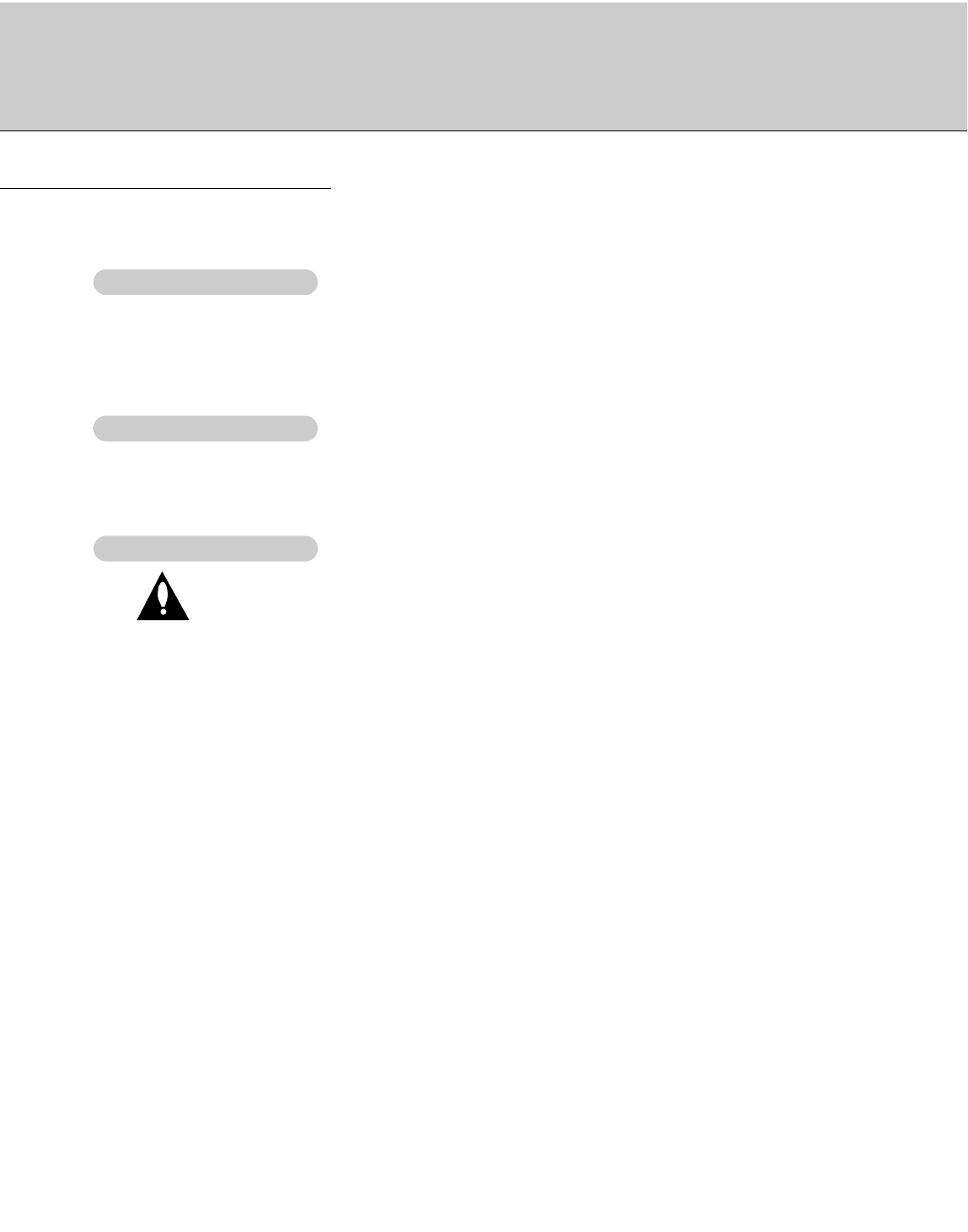
27
1. Here’s a great way to keep the dust off your screen for a while. Wet a soft cloth in a mixture of lukewarm water and
a little fabric softener or dish washing detergent. Wring the cloth until it’s almost dry, and then use it to wipe the
screen.
2. Make sure the excess water is off the screen, and then let it air-dry before you turn on your Monitor.
To remove dirt or dust, wipe the cabinet with a soft, dry, lint-free cloth.
Please be sure not to use a wet cloth.
If you leave your Monitor dormant for a long time (such as a vacation), it’s a good idea to unplug the
power cord to protect against possible damage from lightning or power surges.
- Early malfunctions can be prevented. Careful and regular cleaning can extend the amount of time you will have your
new Monitor. Be sure to turn the power off and unplug the power cord before you begin any cleaning.
Maintenance
Cleaning the Screen
Cleaning the Screen
Cleaning the Cabinet
Cleaning the Cabinet
Extended
Extended Absence
Absence
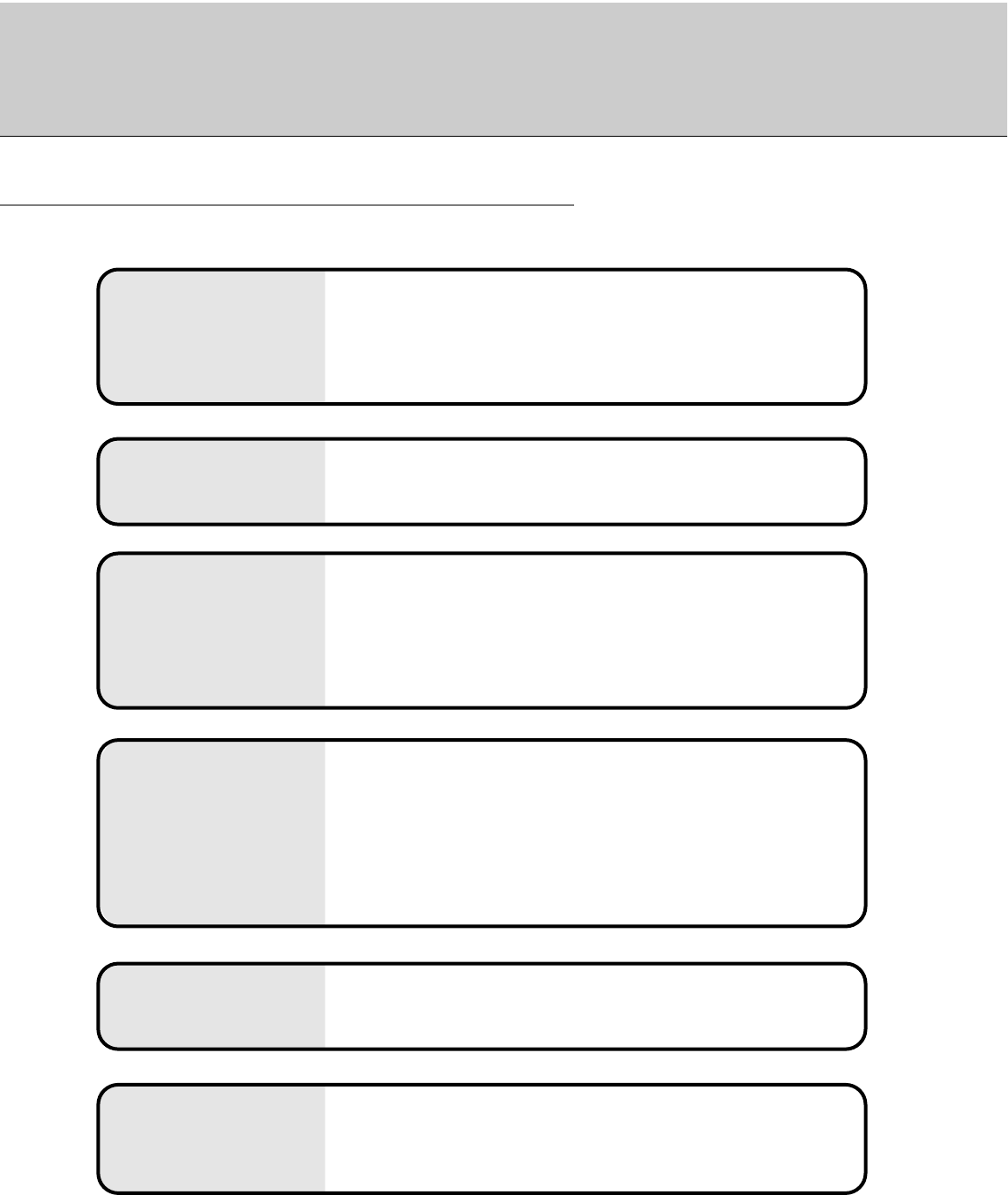
28
Troubleshooting Checklist
No output from one of
the speakers •Adjust Balance in the AUDIO menu. (Refer to p.14)
Strange sound from
the Monitor •Typical sound due to normal Monitor operation, Monitor is not faulty.
No picture &
No sound
•Check whether the Monitor is turned on.
•Power cord inserted into wall outlet?
•Plug another product’s power cord into the wall outlet where the
Monitor’s power cord was plugged in.
No or Poor color
or Poor picture
•Select Colour in the VIDEO menu and press the VOLUME (G) but-
ton. (Refer to p.13)
•Keep a certain distance between the Monitor and the VCR.
•Activate any function to restore the brightness of the picture. (If still
picture is on the screen for more than 5 minutes, the screen gets
dark.)
The remote control
doesn’t work
•Check to see if there is any object between the Plasma Display and
the remote control causing obstruction.
•Check to see if the batteries are installed with the correct polarities.
(Refer to p.10)
•Install new batteries. (Refer to p.10)
Picture OK &
No sound
•Press the VOLUME (G) button.
•Sound muted? Press MUTE button.

29
Note

30
Note
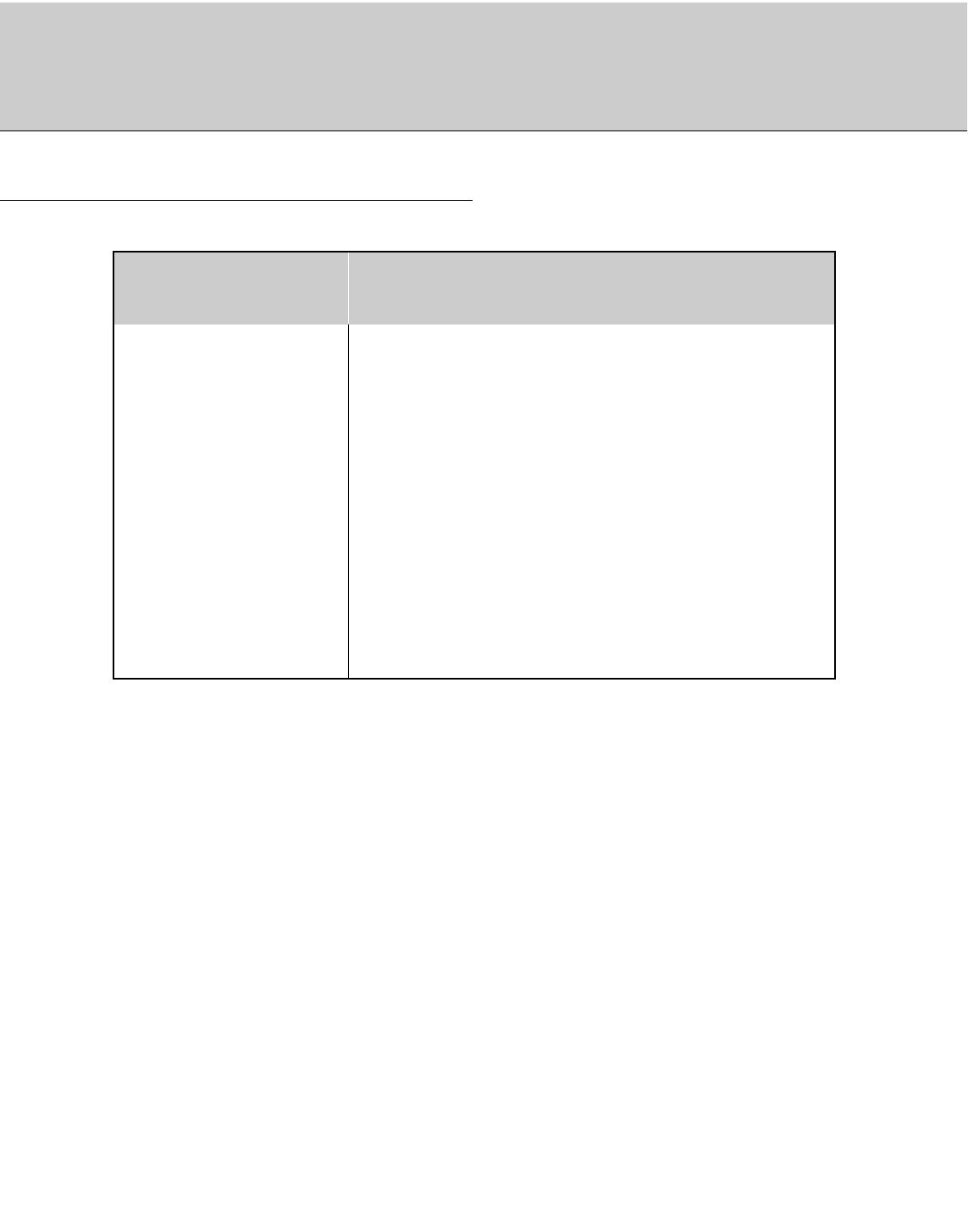
31
Product specifications
MODEL
Width (inches)
Height (inches)
Depth (inches)
Weight (pounds)
Power requirement
Resolution
Color 16,770,000 (256 steps of each R, G and B)
36.6
28
3.1
71.8
640 x 480 (Dot)
•This product specifications above can be changed without notice for quality improvement.
MU-40PA15/B/G/K/S
AC 120V, 60Hz